Oxford hosts its firstever Oktoberfest
META HOGE SENIOR STAFF WRITER
Miami University students, alum ni and Oxford residents gathered Up town on Saturday for the city’s first Oktoberfest, dubbed Oxtoberfest.
Booths for local retailers and ar tisans lined High Street, and food trucks and stands were set up on Park Place. Right next to Oxford Memorial Park were activities for kids, includ ing inflatables, pumpkin painting and train rides provided by Schwab Fami ly Farm Market.
The Klaberheads, Ohio’s premiere Oktoberfest band, also performed live music in the park. The band played everything from polka to Big Band (jazz and dance music played by a big group) songs to rock music.

Oxtoberfest, “a fall festival, Ox ford-style,” was put together by the
City of Oxford, Enjoy Oxford and the Oxford Chamber of Commerce.
The event brought in the Oktober fest theme through stands with Ger man, craft and domestic beers and the Burgermeister’s Beer Garden, sponsored by Steinkeller. The garden had select beer tastings and flights. People dressed up in lederhosen and dirndls.

Sarah Osinkosky, a Miami alum na, dressed up with her family, in cluding her dad, Mayor Bill Snavely. Osinkosky, who lives in Middletown, said she came to the event for her dad and in memory of Todd Hollenbaugh, who passed away last year and was a previous owner of Mac and Joe’s and Steinkeller.
“[He] was one of my dad’s best friends,” Oskinkosky said. “My dad
Miami Theater’s 'These Shining Lives' truly shone

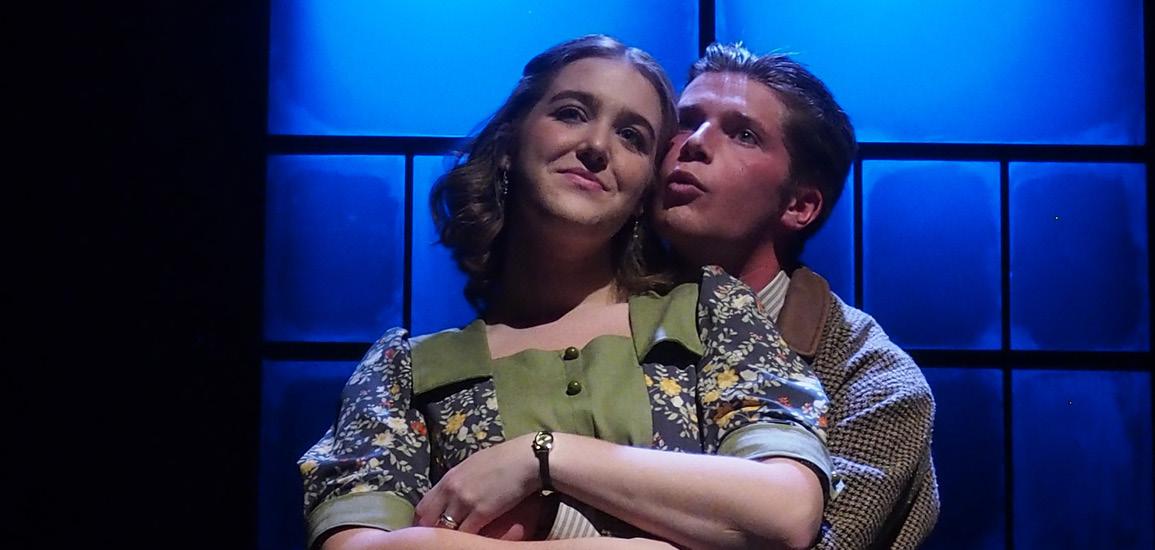
THE MIAMI STUDENT
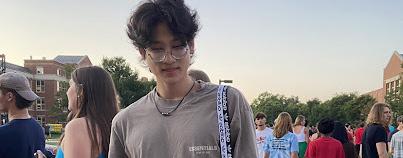

Time just ran out to see Miami University Theater’s production of “These Shining Lives,” but its mes sage still lingers.
The historical play centers around four women in the 1930s who got radium poisoning from their facto ry job painting watches. Meanwhile, their doctor and boss ignore their complaints. The women then fight for justice against the doctor and boss for enabling their sickness. Their power in solidarity reflects today’s urge to hold higher-ups accountable for their errors.

“They were always so willing to be stretched,” Wiggins said. “What really resonated with them was the message of women's rights.”
The actors handled the serious scenes, which spanned from the courtroom to the dining room, un flinchingly. They easily adapted to the setting, despite its old language.
The play’s lighting went from a standard antique yellow to deep blues to ultraviolet darkness, when the ra dium glowed inside the women for the first time. Massive dirty window
SEAN SCOTT CAMPUS
On March 17, almost a thousand faculty members were invited to take an anonymous survey to assess then-Provost Jason Osborne’s threeyear tenure at Miami University.
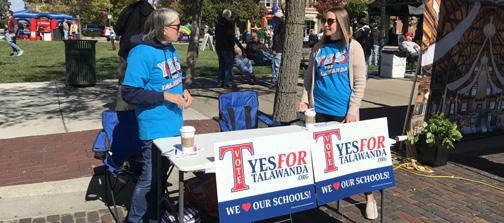
Over the course of two weeks, more than 37% of eligible faculty members left comments on the sur vey. The 352 respondents left more than 1,400 comments.
Five faculty members were cho sen to be part of the committee, called the All-University Faculty Committee for the Evaluation of Administrators, which reviews the results.
It was tasked with writing Os borne’s three-year evaluation report based on the survey results. After presenting its findings with the uni versity’s president, the committee would then share the report with the rest of the Miami community.
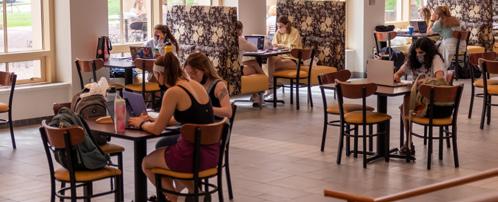
But the report was never pub lished.
Instead, Osborne resigned just four days before it would have been finalized.
After months of investigation, The Miami Student has obtained the survey results and a rough draft of the committee’s report through multiple public records requests. The Student has created a timeline of events leading to Osborne announc ing his resignation on April 11 and the termination of the final report ahead of its April 15 deadline.

In the time since, Osborne has ac cepted a position as special assistant to the president, even as the univer sity spent $24,000 on an external investigation into his conduct.
In an email to The Student, Jes sica Rivinius, interim vice president for communications, wrote that Os borne would be unable to answer questions related to the story.
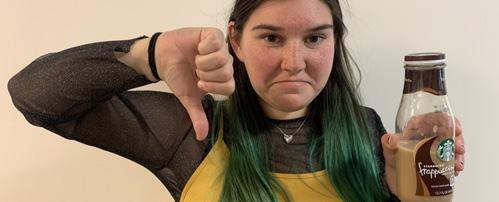

“Jason Osborne is unavailable to respond at this time,” Rivinius wrote. “He is on intermittent FMLA leave, caring for a terminally ill fam ily member.”
Mac Hippenhammer is making the most of his final season at Miami
LINDSAY STEVENSON THE MIAMI STUDENT
It’s second and goal. The first half is going to end in less than a minute. Miami University’s defense has been good today; it held Northwestern University to just seven points in the first half. But the offense hasn’t been able to strike.
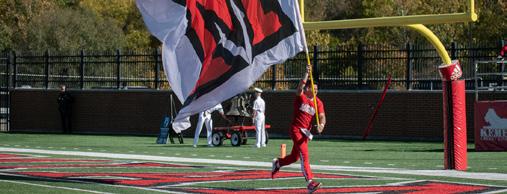

The RedHawks’ line up on the 12-yard-line across from the North western Wildcats, down seven in front of a hostile crowd of over 23,000 people. The ball is snapped, a play is made, and the quarterback finds standout wide receiver Mac Hippenhammer in the end zone, ty ing the game and silencing the crowd.
For some of the Red Hawks, who typically see home crowds of only a few thousand people, the immense audience might be overwhelming, but not for Hippenham mer. Unlike his team mates, he spent the first three years of his college football career at Penn State, which he says prepared him for high pressure situations like these.
“When you understand the game you don't really panic,” he said. “I've obviously been around this for a while, especially playing at Penn State in front of like 100,000 people in these games. I'm kind of used to these environments.”
Hippenhammer added that play ing in front of large away crowds was actually one his favorite experiences.
“When you know what you're do ing, you take it all in,” he said. “Mak ing a big play, especially at an away game, and hearing everybody go si lent and celebrating with your team mates is a surreal feeling.”
When Hippenhammer decided to transfer for his fourth and fifth year,
 LUKE MACY
LUKE MACY
ASST. CAMPUS & COMMUNITY EDITOR
& COMMUNITY
EDITOR
EVAN STEFANIK
Visiting director Torie Wiggins al lotted the students time to learn the history.
Volume 151 No. 5 ESTABLISHED 1826 — OLDEST COLLEGE NEWSPAPER WEST OF THE ALLEGHENIES Miami university — Oxford, OhioTHURSDAY, OCTOBER 13, 2022 CONTINUED ON PAGE 11 CONTINUED ON PAGE 11 CONTINUED ON PAGE 7 CONTINUED ON PAGE 4 "THESE SHINING LIVES" HIGHLIGHTS CATHERINE AND TOM'S RELATIONSHIP AS HER HEALTH DETERIORATES AFTER WORKING FOR RADIUM DIAL. PHOTO BY GION DEFRANCESCO HIPPENHAMMER ENJOYS CROWDS AT AWAY GAMES FOR THE ROAR OF THE CROWD PHOTO BY JESSICA MONAHAN SPORTS RedHawk roundup: hockey impresses against ranked opponent, field hockey’s tough weekend and more - page 10 HUMOR The Silly, The Goofy, The Quirky Jaywalking Lads. - page 13 In this issue CAMPUS & COMMUNITY School district levy creates controversy in the community - page 6 PHOTO Fall break in the mountains - page 16 ENTERTAINMENT The only thing ‘Carmilla’ film adaptations have in common with the titular character: They suck - page 8 FOOD A non-coffee drinker’s guide to cafes in Oxford - page 9 THE FIRST OXTOBERFEST WAS HELD DURING MIAMI UNIVERSITY'S HOMECOMING WEEKEND. PHOTO BY GRACE AXLUND THE KLABERHEADS, OHIO'S PREMIER OKTOBERFEST BAND, PROVIDED LIVE MUSIC IN OXFORD MEMORIAL PARK. PHOTO BY SARAH FROSCH GRAPHIC BY MACEY CHAMBERLIN "Faculty morale has never been lower" "...he wants POWER..." "...generated a culture of fear..." "The entire office needs to be replaced." "...leadership has been gaslighting us for 2 years." "He has hired a number of people, and all are strong leaders..." "...just as tone-deaf and profit-driven as all other universities." "The worst provost we have ever had (and we certainly have had many bad ones)." "...junior and female colleagues have felt that their interaction is a 'power/bullying' space..." "He is a liar, manipulator, and a fool. He needs to be fired." "...fair and consistent in decision making." "Does not play well with others." "... useless lump..." " ...living in a completely different world..."
ANNA REIER THE MIAMI STUDENT
The Weekend Update is not your typical com munity newsletter.
“An 18 year old was mega intoxicated trying to get into the wrong address,” an Oxford Police Department (OPD) Facebook post from Aug. 29 reads. “When the police officer arrived, he did not grasp the whole uniform look and asked the offi cer ‘what year are you in school?’”
Snippets like this one are posted weekly to the Oxford Police Department’s Facebook page. These posts started in 2017, when Lieutenant Lara Fening decided it was time to find a way to directly communicate with the community.
“I had wanted to put out an informative up date, just in the interest of community outreach,” Fening said.
She emphasized that in this new era of news, people need to get more creative with how they are presenting information to the world. Fening said that nowadays “people don’t know how to receive information.”
Fening believes that as newspapers and other traditional forms of media become less promi nent, there is confusion surrounding the best way to communicate with local organizations, like po lice departments.

“I think that it is a tool that we use to improve the communication with our public,” Fening said. “With the feedback we have received from the public, we feel that it has worked out fabu lous.”
Fening said the average resident appreciates the updates as the police department works to ward transparency with its constituents.

“Even if it’s minor, they are being informed on the front end,” Fening said.
But some, like Miami University Dean of Stu dents Kimberly Moore, feel the Weekend Update aids in stereotyping the university’s student body.
“Sometimes we have an urge to throw a monolithic view over the student body,” Moore said. “Students seem to be getting more and more diverse in their interests.”
Fening said she never identifies anyone as a student of Miami, but there’s some level of as sumption involved.
“I never say that it is a student,” Fening said.
Jake
Sarah
Skyler
Devin
Fred
Sacha
“Perhaps there is an implication from the reader that that is what it is.”
To Moore, the updates target Miami students, even if they don’t call out the university by name.
“There’s a ton of assumptions in this town, that’s easy to do,” Moore said. “When you have a town of six to eight thousand that all of a sudden balloons to 26,000 people, it’s easy to assign Mi ami students responsibility that may or may not be factual.”
Ava Ostrom, a first-year psychology major, believes there are unfair student implications.
“I understand why people would feel [offend ed] because the Weekend Update often shares details that don’t necessarily need to be relayed to the public,” Ostrom said.
Fening believes otherwise.
“The benefits we see from that outreach out weighs that kind of criticism we might get from revealing what is public record,” Fening said.
Jonathan Vigoa, a first-year kinesiology ma jor, feels it is a great way to stay informed about what is going on in the community.
“It is really interesting to see what happens on the weekends, and makes me feel like I’m in formed about what’s happening,” Vigoa said. “It is also very interesting to read.”
As to why there’s contention over the Week end Update, Fening thinks it has everything to do with the light shed on student activities.
“There have been times when Miami has probably not wanted to see it” Fening said. “”It’s highlighting [student issues] to them.”
Another point of contention is the tone in which these updates are written.
Fening said people will read the updates as funny regardless of the tone she writes them in. Fening said OPD avoids including stories of a sensitive nature, and she reads through every report multiple times before it gets published to find stories that are helpful to the public.
Moore encouraged students unhappy with the update to have conversations with others and not put too much value in the posts.
“I have 100% faith in our Oxford Police De partment,” Moore said, “and that they would be willing to listen and have a conversation.”
Things to do
Starup Weekend 2022
times
Depression Screenings
a.m. -
p.m.
Family Weekend Events
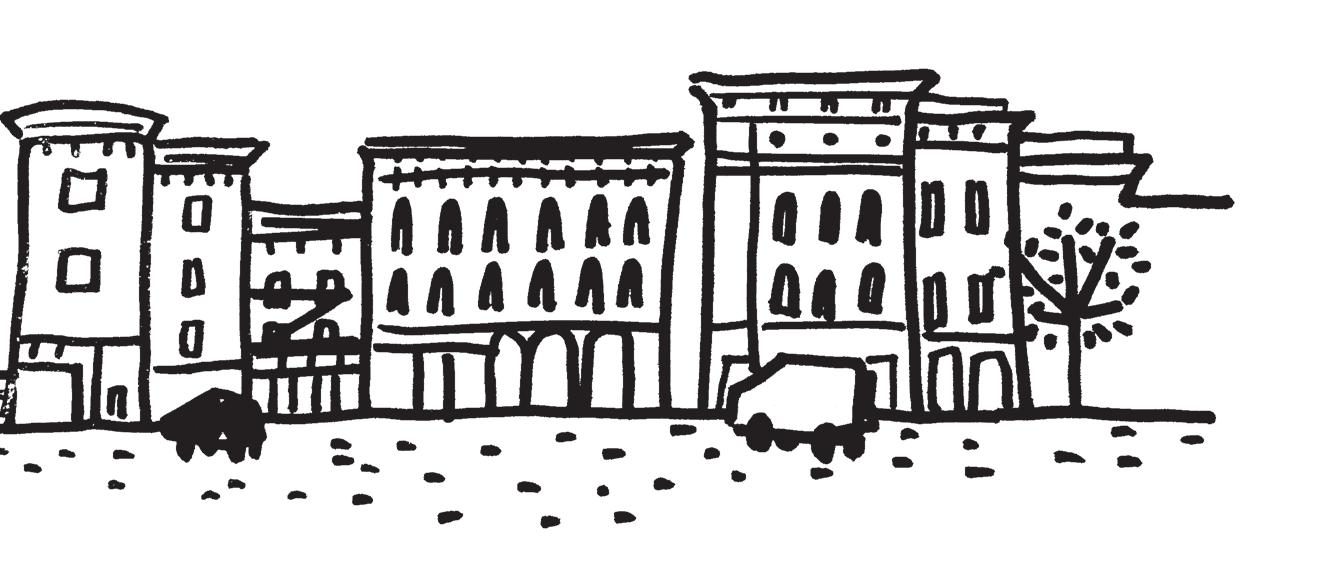
Sat

Walking Tour of Sacred Sites
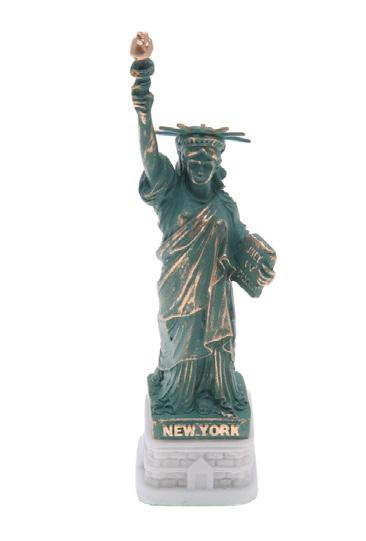
times
Oxford
p.m.4 p.m.
Identity and Exploration Film
p.m.7:30 p.m.
@AnnaReier reieram@miamioh.edu
Safe Zone 201 10 a.m.Benton Hall 115 Attend this workshop to learn how to support transgender and nonbinary individuals. 10/13 Thu
Various
Farmer School of Business Join entrepreneurs for this week-long business competition.10/14 Fri
11
2
The Seal Receive free, confidential depression screenings and visit resources tables.10/17 Mon
Various
Various locations Join MAP and the Oxford community for events during Family Weekend 2022 on Friday and Saturday. 10/21 Fri A
in
2
Begins at the Phi Delt gates Join Miami’s Department of Comparative Religion for a walk around Oxford sacred sites. 10/22
Disability
5
Shriver Center (Admission Auditorium) Watch and discuss “Crip Camp” with The Miller Center for Student Disability Services.10/25 Tue THURSDAY, OCTOBER 13, 2022Coming Up... 2 GRAPHIC BY SOREN MELBYE The Weekend Update… informative or insulting? Citizenship and Democracy Week SEPTEMBER 19 22 2022 Monday Sept 19 | 10 a m | Quad and Lawn Hamilton Campus U S District Court Naturalization Ceremony Join us on the Hamilton Campus as we host the U S District Court for the Southern District of Ohio for the formal swearing in of approximately 75 new U S citizens Tuesday, Sept 20 | 10 a m | Harry T Wilks Conference Center, Hamilton Campus Live On campus Proceedings: Ohio 12th District Court of Appeals The Ohio Court of Appeals for the 12th District will meet on campus to hear arguments in two pending appellate cases in the Ohio courts Tuesday Sept 20 | 10 a m 2 p m | Johnston Hall Parking Lot Middletown Campus donortime com/donor/schedules/drive schedule/62120 Wednesday Sept 21 | 10 a m 2 p m | Schwarm Hall Parking Lot Hamilton Campus donortime com/donor/schedules/drive schedule/62075 Blood Drives Give back to your community by giving blood and enjoy some free merch! Appointments with the Community Blood Center s Bloodmobile can be made online above Wednesday, Sept 21 | 5 p m | Shriver Heritage Room, Oxford Campus Lecture: “Authority and Democracy” Featuring Daniel Ziblatt In this lecture Daniel Ziblatt Ph D co author of the 2018 New York Times bestseller How Democracies Die and the Eaton Professor of Government at Harvard University will discuss what history tells us about the state of democracy today and what may lie ahead Presented in cooperation with the Miami University Humanities Center Visit MiamiOH edu/Menard Events for remote attendance Thursday, Sept 22 | 10 11:30 a m | Schwarm Hall Dining Area, Hamilton Campus Rapid Rights! Miami students share their research via brief presentations on some of the key civil liberty issues that face Americans today Thursday Sept 22 | Noon 1 p m | Jack Rhodes Study Mosler Hall Hamilton Campus Campus Free Speech Forum Participate in a non partisan open forum to discuss free speech law and contemporary free speech controversies including the limits of on campus speech the scope of protections for social media platforms and more Come ready to share your ideas! Moderated by Daniel Hall professor of Political Science and Justice & Community Studies Thursday Sept 22 | 3 4:30 p m | Armstrong Student Center 1082 Oxford Campus Careers in Civic Engagement Fair Interested in a career in public service? Learn more about public service oriented career opportunities and meet with employers from think tanks nonprofits and governmental organizations at this free event All events are free and open to the public; no tickets are required unless otherwise noted Most awarded college newspaper in Ohio at the 2020 Regional Mark of Excellence Awards by the Society of Professional Journalists. COSETTE GUNTER-STRATTON EDITOR-IN-CHIEF Advertising information: ankenedw@miamioh.edu Send us a letter? eic.miamistudent@gmail.com The Miami Student is published biweekly during the school year by the students of Miami University in Oxford, Ohio. The content of The Miami Student is the sole responsibility of The Miami Student staff. Opinions expressed in The Miami Student are not necessarily those of Miami University, its students or staff. CORRECTIONS POLICY The Miami Student is committed to providing the Miami University community with the most accurate information possible. Corrections may be submitted up to seven calendar days after publication. Abby Bammerlin Managing Editor Macey Chamberlin Soren Melbye Design Editors Lexi Whitehead Senior Campus & Community Editor Sean Scott Campus & Community Editor Jack Schmelzinger Sports Editor Ames Radwan Opinion Editor Devin Ankeney Asst. Opinion Editor Luke Macy Alice Momany Maggie Peña Reagan Rude Asst. Campus & Community Editors Emily Hogan Erin McGovern Hannah Potts Designers Mihaela Manova Style Editor Teddy Johnson Patrick Sullivan Humor Editors Maggie Peña Sean Scott Entertainment Editors Reece Hollowell Asst. Entertainment Editor Megan McConnell Claudia Erne Social Media Editors Ames Radwan Food Editor
Ruffer Photo Editor Jessica Monahan Asst. Photo Editor
Grace Hays Audio Editor Hannah Horsington Video Editor
Perry Magazine Editor
Ankeney Business Manager
Reeder Jr. Faculty Adviser
Bellman Business Adviser Aim Media Midwest Printer
City Council addresses environment in October meeting
City Manager Doug Elliott agreed that improving the city’s transpor tation is an important concern but wanted to wait until 2024.
“Staff and I agree we need to up date the transportation plan,” Elliott said, “but we feel that it should be done in 2024. We’ve got a lot of proj ects on the table.”
Elliott said other programs, such as adding a new public restroom, would have to be cut from the bud get, and the city manager’s office would need to hire additional staff to have the resources to update the transportation plan in 2023. With the additional staff member, the update would end up costing $150,000.
Public participation ends in argument
Carissa Schnell, Oxford resident, took the stand during public partici pation to talk about the resolution of dissent against the Supreme Court’s overturning of Roe v. Wade that passed at the previous meeting.
“It was good to hear both sides of a very sensitive topic,” Schnell said, “but I wish we could have had that conversation before you guys started or enacted a resolution and voted on it.”
During her five minutes, Schnell also said she wished Oxford would host more “Living Room Conversa tions” for residents to discuss similar topics.
everybody the same, and we did listen to you, and we listen to everybody, and we give everybody five minutes.”
Schnell continued to talk for an other minute before leaving the stand.
Two resolutions passed for OVI task force
Council unanimously agreed to accept a resolution allowing the City of Oxford to act as the lead agency for the Operating a Vehicle under the Influence (OVI) task force for Butler County.
The resolution also allowed the city manager to enter a $250,000 grant agreement with the Ohio De partment of Public Safety.
LUKE MACY ASST. CAMPUS & COMMUNITY EDITOR
After a packed and long meeting in September, Oxford City Council gathered for its first meeting of the month on Oct. 4 at the Oxford Court house. This meeting also had a large audience, with more than 25 people, and ended up running for more than two hours.

Council passes one of two resolutions related to environmental issues Councilor David Prytherch intro duced a resolution, in conjunction with the Parking and Transportation Advisory Board, to amend the pro
posed 2023 Capital Improvements Budget to give $100,000 to update the city’s transportation plans, rather than waiting until 2024.
“If we want to complete our streets and our Oxford area trail, we have to have a plan, and we have to have cost estimates,” Prytherch said. “I know it’s planned for 2024, but I think it’s better to do it sooner rather than lat er.”
Possible topics the updated trans portation plan would cover included updating pedestrian-bike infrastruc ture, addressing carbon emissions and making transportation more ac cessible. Prytherch also said updating the plan was a top concern among residents.
A guide to navigating
Oxford’s general election ballot
LUKE MACY ASST. CAMPUS & COMMUNITY EDITOR
This year’s general election is approaching quickly, with the polls opening Nov. 8. Here’s what’s on the ballot in Oxford.
What’s on the ballot?
Headlining the November ballot is the Ohio governor race, with current Republican Gov ernor Mike DeWine facing off against former Dayton Mayor Nan Whaley, the Democratic nominee.
One U.S. Senator seat will be up for grabs in the election. Democratic nominee and Ohio Representative Tim Ryan will compete with Trump-endorsed Republican nominee and au thor JD Vance.
Oxford falls into the 47th House District, which also includes Hamilton. Republican Rep resentative Sara Carruthers and 19-year-old Democratic nominee and Miami University student Sam Lawrence are competing for state representative for the district.
Ohio also has two state issues on this year’s ballot.
State Issue one will require judges to con sider public safety, the seriousness of an offense and the criminal record of the defendant when setting a criminal defendant’s bail.
State Issue two will prevent non-U.S. citizens from voting in local elections. Ohio has allowed its local governments to make these decisions, but if the issue passes, Ohio will change its con stitution to only allow U.S. citizens to vote in local elections.
Currently, only one municipality, Yellow Springs, has allowed non-U.S. citizens to vote in local elections.
For those who live within the Talawanda School District, the school has a levy on the bal lot that, if passed, will generate $4.8 million a year for the school district. The levy will increase
Councilor Jason Bracken brought up the fact that updating the plan could possibly get grants faster.
Councilors Bracken and Prytherch were the only ones to vote yes on the resolution.
Prytherch then shared another resolution that would also amend the 2023 budget, this time for allocating $50,000 to the funding of consulting services that would study the feasi bility of renewable energy sources in Oxford. The budget originally had $25,000 for looking into the use of solar energy.
The city currently has a commit ment to reducing greenhouse gas emissions 50% by 2030 from 2019.
The resolution was adopted unan imously.
“We need to find ways to bring this community together rather than pull something that is a national and a state topic and bring that divi siveness right here to a local level,” Schnell said. “I get the impression that it’s more about what’s happening in your own political bubble rather than what’s happening across the spectrum.”
After Schnell’s five minutes were over, Mayor William Snavely asked her to leave the stand. However, Schnell refused.
“Well, thanks Mr. Snavely, but here’s the thing,” Schnell said. “I know that you’re not just smiles and sweater vests.”
“That was uncalled for,” Snavely replied. “Here’s the thing. We treat
The grant will be divided among 13 Butler County agencies to operate saturation patrols, where multiple of ficers monitor a certain area for signs of impaired driving, and OVI check points to protect highway safety.
The council also unanimously ap proved a contract for Peter Reising to work as the OVI Task Force Coordi nator for the 2023 federal fiscal year. Reising has served as the coordinator since 2015, although his retirement in 2016 switched him to a contract em ployee. The resolution allows him to be paid $60 per hour.
“Such an awesome relationship that we can continue to maintain with Pete,” Prytherch said.
Oxford City Council will meet again at 7:30 p.m., Oct. 18, in the Ox ford Courthouse.
macylj@miamioh.edu
property taxes by $199.50 annually for every $100,000 in assessed value.
The full list for Butler County’s ballot can be found online.

Why should you vote?
At the Oct. 4 City Council meeting, Councilor Glenn Ellerbe expressed hope that Miami stu dents would register for the election.
“A lot of students don’t know this, but be cause you have housing here in Oxford for the majority of the year, you are eligible to register here to vote,” Ellerbe said. “I highly recommend anybody who has an interest in their civic duty here in Oxford, please go out and register to vote.”
Reena Murphy, a graduate student with in Miami’s Wilks Institute for Leadership and Service, has been working to promote civic en gagement among students. Murphy said the in stitute is achieving this through tabling events, programs focused on why voting matters and boxes to collect student voter registration forms.
Murphy said voting is important for people to express their beliefs.
“Your vote has power,” Murphy said. “It is a formal way to express your opinion on local leadership, state leadership, federal leadership and for you to see your values and priorities aligned with the candidate you vote for. One of the reasons that matters so much to young peo ple is we are quickly becoming one of the largest voting blocks in the country.”
Cameron Tiefenthaler, the Associated Stu dent Government’s secretary for governmental relations, wants people to know the impact vot ing locally can have.
“One of the most important things that gets overlooked is the level of decisions that are made at the local level,” Tiefenthaler said. “If you have qualms that you have potholes or that you don’t have a streetlight on your street or there’s some thing that you don’t like about the way that the
school board is currently operating, that’s a de cision that you can have a direct impact on.” Murphy and Tiefenthaler both said voters should do research on the people they’re elect ing. Murphy suggests requesting an absentee ballot, so voters can look up the issues they’re voting on as they go. Tiefenthaler suggests vot ers interact with the people they’re electing to understand their opinions.
When, where and how do you vote?
Figuring out what to vote on is entirely up to you, but figuring out how to do it is a different task.
A 2022 study titled “Cost of Voting in the American States” ranked Ohio 10th for states with the most barriers to voting.
Early in-person voting and absentee voting
began Oct. 12. Early voting times and requests for ballots by mail can also be found on the Sec retary of State’s website.
Noon on Nov. 5 is the deadline to request an absentee ballot and mailed absentee ballots must be postmarked by Nov. 7. Absentee ballots can also be turned in to the Butler County Board of Elections by 7:30 p.m. on Nov. 8.
The general election begins at 6:30 a.m. on Nov. 8 and ends at 7:30 p.m. Polling places in clude Talawanda Middle School and Miami’s Marcum Hotel & Conference Center. Residents can find their specific voting places at the Butler County Board of Elections website.
THURSDAY, OCTOBER 13, 2022 3 Are you a: • writer • photographer • designer • or illustrator? Visit miamistudent.net to Join the TMS Team! “[TRANSPORTATION] IS THE ONE [THING] THAT WE DO KICK DOWN THE ROAD TO OUR PERIL,” OXFORD RESIDENT CARLA BLACKMAR SAID. PHOTO BY LUKE MACY
macylj@miamioh.edu
GRAPHIC BY HANNAH POTTS
How Jason Osborne’s tenure as Miami’s provost came to an end
Mulitple
The

Jason Osborne’s thirdyear review survey is sent to
faculty members.
Executive Assistant to the President Ted Pickerill shares the
results with Committee Chair Andrew Paluch, President Greg Crawford and Osborne himself.
The provost works as the chief ac ademic officer for the university.
According to the position descrip tion in Osborne’s personnel file, the provost has “ultimate responsibility for all academic programs, opera tions, and initiatives.” The provost is also expected to manage a “signif icant part” of the budget for academic operations.
Other responsibilities include oversight of faculty promotion and tenure and management of the ad ministrative structures of each aca demic college and center at Miami. All academic deans and members of the Provost’s Office report directly to the provost.
Miami launched its Strategic Plan, a guiding document for the uni versity’s future, in July 2019. When Osborne came to the university one month later, he had the additional responsibility for “the creation and implementation of programs conso nant” with this plan. At the time of his hire, the Provost’s Office budget was $13 million.
Who is Jason Osborne?
Osborne was hired by Miami to serve as provost starting the fall of 2019. Before Miami, Osborne was dean of Graduate Studies at Clemson University and a department chair at the University of Louisville.
According to his resume when he applied to Miami, Osborne has worked at seven different colleges and univer sities since 1993, now eight including Miami. Ohio is the seventh state where he’s held a job in higher education.
During his tenure at Miami, Os borne helped oversee the implemen tation of a new strategic plan, the cre ation of the Honors College and the transformation of the Global Miami Plan to the Miami Global Plan.
Within Osborne’s first year as provost, Miami also shut down in re sponse to the COVID-19 pandemic, leaving him to lead the university in unprecedented times.
In an email to The Student, Presi dent Greg Crawford praised Osborne for his work as provost.
“During his tenure as provost and executive vice president for Academic Affairs, Dr. Osborne helped to lead the university through an unprece dented and uncertain time in higher education due to the COVID-19 pan demic,” Crawford wrote.
Rivinius echoed Crawford’s praise in the same email to The Student.
“Jason’s leadership throughout the period of Covid-19 was greatly ap preciated and his work on the Miami University strategic plan and Boldly Creative helped to establish the pos itive trajectory for Miami’s future,” Rivinius wrote.
What’s a third-year evaluation?
The faculty committee which evaluates administrators reviews the provost, all academic deans, the as sociate provost for research and dean of the graduate school, the dean and university librarian and the univer sity director of Liberal Education in their third and fifth years at Miami.
Members are chosen by their academic divisions through Uni versity Senate election procedures. Osborne’s committee was originally made up of seven faculty members, Terri Barr, Stephanie Baer, Ginny Boehme, Daniel Hall, Andrew Pal uch, Phillip Smith and Cathy Wagner. However, after Smith and Wagner re cused themselves from working on the report due to conflicts of interest, Osborne’s committee ended up with five members.
The review is intended to help with the professional development of these administrators and help base future decisions for these positions. All responses made on the survey are anonymous.
Third-year reviews for adminis trators ask a set of standard ques tions, and the administrators being evaluated are also allowed to add questions of their own.
Paluch, an associate professor in chemical engineering, was chosen by the committee to be the chair during its review of Osborne. Paluch said the wording of some questions had to be updated over time, and Osborne gave feedback for the standard questions as well as his own additions.
Paluch said Osborne seemed ex cited about the prospect early on in
the process.
“He was all in,” Paluch said. “... He was excited that he was going to get some feedback that he could use in some constructive way to make himself better. He was maybe a little too into it in terms of going back and forth with questions.”
When the raw survey results came in, the comments painted a less than rosy picture.
The survey by the numbers
Based on the responses, Osborne was not a popular provost.
The survey included 37 questions ranked on a scale from 1 to 5, fol lowing the Likert scale. A score of 1 meant the survey respondent strong ly disagreed, while a 5 meant the re spondent strongly agreed.
Across the quantitative questions, Osborne’s highest average was 2.83 in supporting appropriate technol ogy resources — less than a neutral response of 3.
He earned his lowest score, 1.51, in valuing and achieving high faculty morale.
Osborne’s review also motivated significantly more faculty members to respond to the survey compared to the previous provost, Phyllis Callah an. In 2016, Callahan received about half as many responses as Osborne did with a response rate of only 21%. Callahan received an average score between 3 and 4 on all but one section where she scored a 2.96 for valuing and achieving high faculty morale. Callahan retired after serving four years as the provost.
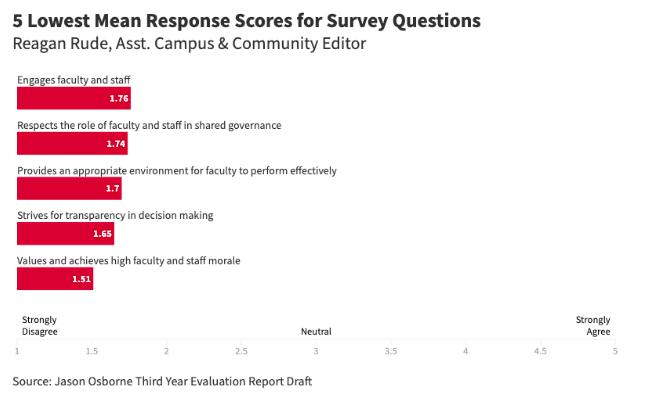
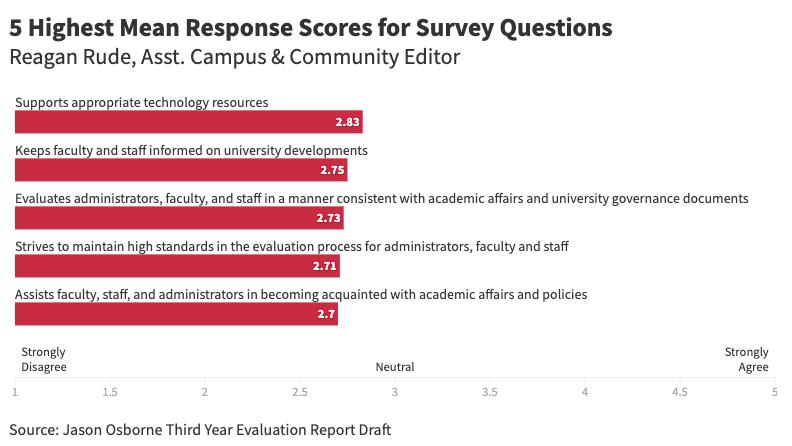
The Student is publishing the survey results online. The Student has decided to exclude a portion of one comment to balance the public’s need for informa tion against harm in accordance with the Society of Pro fessional Journal ists Code of Ethics. The document also includes sections marked “Redacted” where Miami’s Gen eral Counsel has removed sections that it believes is not something that should be available to the public.
Because Miami is a public universi ty, it has to submit to public records re quests, such as the Freedom of Infor mation Act (FOIA) requests. Over the course of its investi gation, The Student submitted multiple FOIAs to obtain rel evant documents.
The editorial staff collaborated with a lawyer and an expert on media ethics before decid ing to include the results in its final
Crawford sends Osborne a formal letter accepting his resignation. Osborne signs it the same day.
11:19 a.m. - Pickerill emails Paluch saying the committee may have until April 18 to submit the final thirdyear evaluation report if needed.
working together “toward providing a rigorous academic experience” for students.
“We value – and have always val ued – our system of shared gover nance and continually seek ways to bring more voices to the table,” the email read. “Core to our system of shared governance is University Sen ate, the primary university governing body comprised of students, faculty, staff, and administrators.”
Despite this, many faculty mem bers used Osborne’s third-year re view to express their dissatisfaction with how the model has functioned in the past three years.
“[Osborne] has been the opposite of shared governance,” one faculty member wrote. “He makes decisions and presents them rather than invit ing discussion and majority decision making. People don’t feel respected by him or his leadership. They feel diminished and discounted. He has no trust in the expertise within the institution.”
report. As a public record, anyone has the right to request the survey results under Ohio Open Public Records and Open Meetings laws, or Sunshine Laws.
The survey by the comments
In addition to the quantitative questions, participants were invited to answer short response questions. Even though fewer than 400 of the 939 people filled out the survey, they left a combined total of more than 1,400 comments.
“The sheer volume was over whelming, to say the least,” Paluch said.
While the majority of comments were negative, going so far as calling Osborne a “useless lump” and oth er derogatory names, some positive comments shone through. One anon ymous respondent referred to Os borne’s leadership as “one of courage, diligence, vision.”
“The amount of people that take the time to actually fill out the short answer questions is usually pretty small,” Paluch said. “[With] the pro vost, it seemed like everybody took the time to fill them out.”
Beyond a question specifically asking for positive aspects of Os borne’s tenure, in which more than a third of respondents wrote that they had nothing good to say, few comments were supportive. Many positive comments related to his de cision-making and communication around health and safety during the pandemic.

Many comments criticized prob lems with shared governance, diversi ty and inclusion and hiring decisions.
Hesitancy to share
A committee member, who wished to remain anonymous, shared that the responses in the survey might not have even reflected the whole story.
“For some of the more serious comments and allegations, there wasn’t a whole lot of detail, and I think it’s because, for one thing, the people who were mentioning it might have been scared of retaliation,” the com mittee member said. “The comments were supposed to be anonymous, but they were also administered through Miami’s Qualtrics, and so there was probably a little bit of hesitancy from some people about that.”
Some respondents mentioned this in their answers.
“It is unbelievable that this sur vey would include this question,” one respondent wrote, answering a ques tion about strategic initiatives that should receive attention in the future.
“Any specific recommendations will clearly identify respondents.”
Shared governance
In an email to The Student, Ri vinius and Director of Executive Communications and Interim Senior Director of Storytelling Ashlea Jones explained that shared governance refers to faculty and administrators
One question asked respondents to answer if they agreed or disagreed that Osborne “respects the role of fac ulty and staff in shared governance.” More than 80% of respondents ei ther disagreed or strongly disagreed.
One commenter wrote that Os borne welcomed faculty input for “minor” issues such as the univer sity’s contract with Proctorio, a test-proctoring service. On “major” issues like the termination of Visiting Assistant Professors (VAPs), though, the commenter said he acts “without regard for faculty input.”
Another response suggested that the university’s respect for shared gover nance is at its lowest in 30 years or more.
While the University Senate has multiple committees for specific is sues at the university, including the committee which conducted the third-year review, some felt the cur rent avenues aren’t enough.
“Just serving on committees, does not equate shared governance,” one faculty member wrote.
Along with a perceived decline in faculty power, several commenters also mentioned a rise in administra tive positions. According to a 2017 article in Forbes, the ratio of faculty to administrators has declined in higher education across the board, indicating an increase in the number of administrative positions, while ad ministrative spending has increased since the 1980s.
“The Provost’s office has also been the site of the sort of administrative bloat that has plagued higher educa tion in the US for some time now,” one commenter wrote. “In addition, this bloat has come by empowering non-faculty administrators as super visors of faculty. If the goal is really shared governance, then there needs to be less centralization of power in the Provost’s office and less delega tion of power to non-faculty admin istrators.”
Osborne and FAM
Miami faculty members an nounced their intentions to union ize as the Faculty Alliance of Miami (FAM) on Feb. 2. Based on several survey responses, Osborne’s tenure as provost was a major motivating factor for many to join the cause.
“I am iffy on the question of the union,” one respondent wrote, “but what I have witnessed by this provost has pushed me to join FAM.”
Even those against the union rec ognized Osborne’s central role in its formation.
“Your current management style, disregard of shared governance, centralization of power/finance, non-transparency, extremely poor decision making, disregard of opin ions coming from departments/di visions etc., are the primary reasons the union was set into motion,” one faculty member wrote. “Therefore, in order to preserve the current struc ture and potentially prevent a union from forming, for the well being of the university I urge you to step down from the role of provost.”
Two days after Osborne’s resigna tion, FAM announced it was moving from looking for signatures in sup port of the union to authorization cards that would allow it to file for a vote once it received support from 30% of the faculty.
What is a provost and why is it important?
THURSDAY, OCTOBER 13, 2022Special Section 4 ‘Resign.’:
March 31 April 5 April 8April 1 March 17
period to respond to the survey closes.
committee members recommend Paluch meet with General Counsel and the Office for Equity and Equal Opportunity for misconduct concerns.
survey
939
CONTINUED FROM FRONT
5:31 p.m. - Osborne announces his resignation in a faculty-wide email.
5:39 p.m. - Pickerill emails Paluch, telling him a final report is “no longer required.”
5:44 p.m. - Committee member Daniel Hall emails the rest of the committee and suggests they should finalize the report regardless of Osborne’s resignation.
6:15 p.m. - Committee member Ginny Boehme responds to Hall’s email, agreeing.
11:40 p.m. - Paluch shares Pickerill’s email with the rest of the committee and writes that he would support finalizing the report to provide an explanation for Osborne’s resignation.
April 11
April 12
The
been
April 15
9:56 a.m. - Paluch responds to Pickerill, writing, “I am following-up for some guidance.”
1:22 p.m. - Pickerill sends Paluch an email stating that the report does not need to be finalized because Osborne is not completing his third year as provost. He further says that the survey results are not subject to public record laws.
a vote once it received support from 30% of the faculty.
The VAPs, revisited
VAPs are faculty members that the university hires on one-year con tracts for up to five years to assist de partments with teaching workloads.
In 2019, the university had 252 VAPs.
That number soon dropped.
In 2020, as the university shut down due to the COVID-19 pandem ic, Osborne chose not to renew the contracts of more than half of VAPs, dropping the number of VAPs to 107.
In an email to The Student, Riv inius explained that a dip in enroll ment also meant a decrease in the need for more VAPs.
“In 2020, there was a dip in en rollment, caused by students defer ring or pausing their college journey because of the pandemic, leading to a decreased demand for positions categorized as Visiting Assistant Pro fessors,” Rivinius wrote. “All depart ments received the visiting faculty they requested.”
In the survey, 74 responses direct ly mentioned this loss of VAPs, with many responses criticizing the deci sion.
“[H]is utter lack of support for DEI [diversity, equity and inclusion] is shown in the sacking of the VAPs, a cohort in which the underrepresent ed are more numerous,” a respondent wrote. “That he then tried to turn this into a horn blowing celebration, not ing that he had increased the percent of tenure track faculty was beyond appalling. Only the most bilious of toads could have made that despica ble claim.”
Other respondents said the deci sion came as a surprise to them.
“The nonrenewal of potentially over 100 VAPs in 2020 — with no meaningful financial rationale shared with us — was an irresponsible deci sion, the impact of which we are still struggling to understand,” one re spondent wrote.
However, at the time, Osborne said the cuts were made for finan cial reasons, and he asked for de partments to reduce the number of courses being offered which led to a decrease in need for VAPs.
In 2021, Miami’s Board of Trust ees, due to a larger-than-anticipated amount of funding and the largest first-year class in Miami history, ap proved for $24.6 million to be spent on VAPs.
Criticisms of diversity and inclusion
When Osborne first arrived at Mi ami, he hoped to improve diversity and inclusion on campus, even par tially taking on fulfilling the Climate Survey Task Force recommendations, which had a focus on improving the university’s diversity and inclusion.
In an email to The Student, Riv inius said Osborne also helped with another task force regarding diversity and inclusion.
“In 2020, Miami University Pres ident Gregory Crawford appointed the President’s Diversity, Equity, and Inclusion (DEI) Task Force to make recommendations aimed at building a more inclusive, diverse, safe, and welcoming climate,” Rivinius wrote.
“Jason Osborne has been a part of these efforts. Inclusive excellence is part of every single one of the univer sity’s goals.”
Rivinius said since the task force was started, it has achieved 91.9% of the 44 recommendations it presented in 2020.
Some comments applauded Os borne’s work with diversity and in clusion, especially with the Heanon Wilkins Faculty Fellow Program, which recruits 10 culturally diverse
scholars to train for a career in higher education each year.
“The DEI and global affairs com ponents of his position are some of the strongest parts of Provost Os borne’s portfolio,” a respondent wrote. “He has added diversity to his senior staff, supported and stabilized our international presence, and he has worked with departments to firm up the Wilkins fellows.”
However, other survey comments did not agree that Osborne was help ful to improving the university’s di versity and inclusion.
“The Provost allows some people to speak and values their opinion more than others,” one respondent wrote. “Even though he is a strong advocate for DEI, his personal ap proach to who he listens to and allows to speak says otherwise.”
Some comments called out the entire university for a lack of focus on diversity and inclusion during Os borne’s tenure.
“As a female person of color, I have felt even more excluded than at any point in my university career,” one respondent wrote. “At least in the past there was token representation.”
Problems in the Provost’s Office

Some respondents pointed out aggressive behavior they witnessed from Osborne.
“[H]e is a bully,” one respondent wrote. “I have personally watched him bully (or try to bully) women, people of color, and men whom he sees as weak.”
The rest of the comment was re dacted.
The same anonymous member of the committee said some of the comments mentioned such concern ing topics that General Counsel was consulted. Rivinius confirmed that Paluch went to General Counsel, who then coordinated with the Of fice of Equity and Equal Opportuni ty (OEEO) to investigate the claims made against Osborne.

“One of the allegations was serious enough that the chair of our commit tee scheduled an emergency meeting with the General Counsel to basically ask, ‘What the fuck do we do?’ pardon my French,” the committee member said.
On May 2, a Miami employee also filed a complaint with OEEO, a department promoting fairness and
justice that reports to the Provost’s Office, against Osborne. The com plainant argued that she was paid unequally based on sex, sexual orien tation and disability.
Miami had already hired an out side law firm, Keating Muething & Klekamp (KMK), to investigate the similar claims made in Osborne’s sur vey results. The investigation cost the university $24,000.
“Some of the responses also in cluded potential reports of harass ment, discrimination, hostile work environment based on various pro tected classes, including sex, sexual orientation, race, and generalized concerns of retaliation,” KMK’s inves tigation report read. “OEEO also not ed that it had received several com plaints from other Miami employees regarding alleged discrimination by [Osborne] on the basis of sex, sexual orientation, as well as claims of retal iation.”
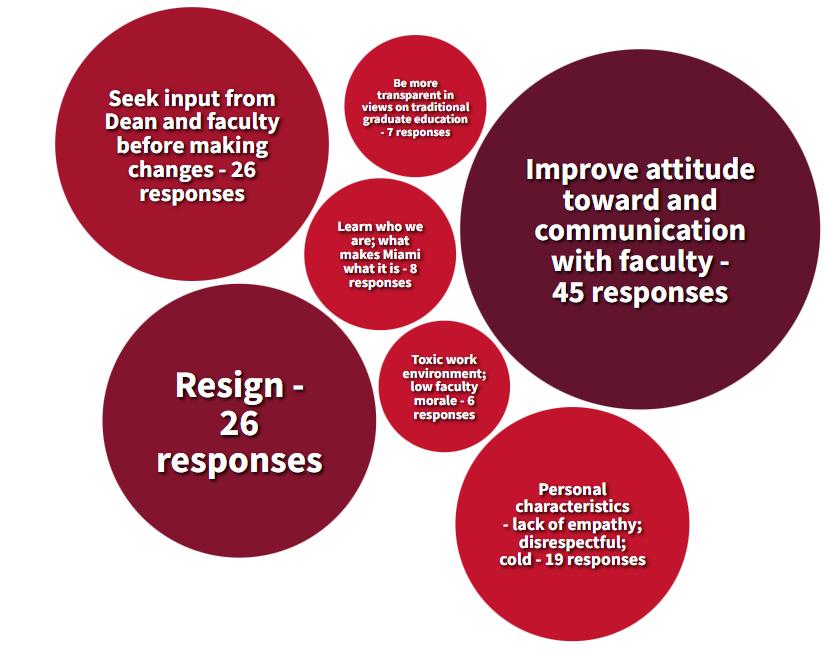
However, after interviewing peo ple deemed to have potentially rele vant information, KMK wrote in its report that it “was unable to substan tiate these allegations.”
Rivinius wrote in an email to The Student that only one formal com plaint was made against Osborne. The other complaints were informal, meaning OEEO could not further in vestigate them.
“The only formal complaint made against Jason Osborne, which was made May 2, 2022 (a few weeks after [he] announced his decision to step down as provost), was thoroughly investigated and deemed unsubstan tiated by KMK,” Rivinius wrote.
What happened after the survey came back?
On Friday, April 1, Ted Pickerill, executive assistant to the president, was sent the raw survey results and shared it with Paluch. In emails ob tained by The Student through a FOIA request, Pickerill wrote of his intent to share the data with both Crawford and Osborne himself.
In the emails, Paluch pushed back. “My opinion would be to go ahead and share with the President,” Paluch wrote. “Then our report is due to the President on April 15, after which a summary report is prepared. Would it be better to share the raw data with the Provost at the same time our report is shared with him? … My thought process is if the data would
be easier to digest when shared with our summary.”
Pickerill responded with the uni versity’s policy text on the commit tee’s procedures. In it, he highlighted a section that reads, “The supervisor [Crawford] and the administrator being evaluated [Osborne] shall have access to all of the faculty responses, including survey results and tran scribed copies of comments.”
The policy does not specify when the survey results should be shared with either the supervisor or the ad ministrator being reviewed.
In a further email, Pickerill clar ified that he made the decision to share the data with both Crawford and Osborne to make the process more open.
“With the policy specifying the su pervisor and the evaluee have access, for transparency sake, providing ev eryone with access at the same time seemed most appropriate,” Pickerill wrote.
Osborne would announce his res ignation 10 days later.
Osborne’s resignation
On Friday, April 8, Crawford signed a letter approving Osborne’s resignation. That morning, Pickerill emailed Paluch, saying that the com mittee could have until April 18 to finish the report if they couldn’t make the April 15 deadline.
Osborne announced his resigna tion in an email to all faculty at 5:31 p.m. April 11.
Multiple comments in the survey results had directly called on Osborne to resign. One respondent put it suc cinctly in a question asking for specif ic suggestions: “Stop rewarding bad behavior. Give people regular leave. Resign.”

Rivinius shared in an email to The Student that Osborne’s resignation was based on personal matters.
“As Jason Osborne shared in an email to the Miami community on April 11, 2022, his decision to step down as provost was a personal deci sion, made with his family,” Rivinius wrote. “He later shared that this deci sion was influenced by his desire and need to focus on his family as they have been battling serious health is sues.”
Eight minutes after Osborne’s res ignation email, Pickerill emailed Pa luch and told him that a final report was “no longer required.”
At 5:44 p.m., committee member Daniel Hall emailed the committee about the importance of maintaining a record and suggested they finalize the report regardless.
At 6:15 p.m., committee member Ginny Boehme offered her support. Neither had seen the email from Pickerill at this point, which had been sent to Paluch only.
At 11:40 p.m., Paluch shared Pick erill’s email with the committee and said he supported finalizing the re port to offer an explanation for why Osborne resigned and help provide insights for future administrators.
“There is also the issue of account ability,” Paluch wrote. “Since the Pro vost is now resigning, is everything
Survey results and additional resources linked here:
erased from history?”
Paluch did not respond directly to Pickerill until the next morning. He asked Pickerill for advice on how to proceed. Pickerill replied just a few minutes later asking Paluch to ac knowledge his first message, which asked the committee to stop the final report.
That afternoon, Pickerill sent a detailed follow-up citing language from the university policy library that said a report would only be pub lished “[i]f the administrator is con tinuing in his or her position for at least one (1) more year.” He also cit ed a court case from Blue Ash, where assessments of managers in the city were not deemed “subject to release under Ohio public records law” as they were only being used for devel opment purposes.
When The Student requested the raw survey results through a FOIA, the university complied, indicating that the results were public record.
On April 13, Paluch emailed then-executive assistant to the pro vost, Stacy Kawamura, that the re port would not be finished.
“The President’s Office has killed the Provost’s evaluation,” Paluch wrote. “They do not want a report and do not want anything released.”
Osborne’s new job
On April 8, three days before an nouncing his resignation, Osborne received a letter from Crawford ac cepting his resignation.
In the letter, Crawford also offered Osborne the role of Special Assistant to the President for July 1, 2022, to Dec. 31, 2022. Osborne would keep his salary until that date, which at the time was $390,000 a year.
“In this role as Special Assistant to the President, you will undertake all such duties as may be assigned by the President of Miami University to the benefit of the university,” the letter read. “You shall devote your full time, attention, skill, and efforts to the faithful performance of your duties, and will continue to receive the bene fits customary with an administrative appointment of this type.”
In an email to The Student, Craw ford said Osborne would be working on some of the programs he started as provost.
“Dr. Osborne is serving as a spe cial assistant in the President’s Of fice this fall until he transitions back to faculty in the spring,” Crawford wrote. “In this role he is completing the many important initiatives he has worked on as Provost, supporting the leadership transition in Academ ic Affairs, and supporting University Advancement’s work on the capital campaign.”
After he finishes the role, Osborne will receive a tenured faculty position in the Department of Statistics with a nine-months salary of $195,000.
According to the Buckeye Insti tute, which compiles salary data for public universities in Ohio, the high est-paid faculty member in statistics, the chair of the department, in 2019 made $225,247. The next highest sal ary was $103,205, just more than half of what Osborne will make as a fac ulty member next year. The average pay for faculty members in statistics at Miami in 2019 was $83,252, and the median pay was $79,788 — both less than half what Osborne will earn.
The letter also said he would be given a paid leave for the spring se mester of 2023, keeping his salary and benefits, while preparing to return to faculty. He would teach one class his first semester, then two classes his second semester, before receiving a teaching load following university policies, which generally require pro fessors to teach at least 6 credit hours each semester — terms he had been offered when he accepted the role as provost. He would also receive a onetime payment of $75,000 for “start up funding” for faculty transition in Spring 2023.
Osborne signed the letter, agree ing to these terms, the same day Crawford offered him the position.
Osborne’s response will be re corded at miamistudent.net when he returns from intermittent family and medical leave.
Additional reporting by Abby Bammerlin, Cosette Gunter-Stratton and Alice Momany.
scottsr2@miamioh.edu macylj@miamioh.edu THURSDAY, OCTOBER 13, 2022 5
MIAMI UNIVERSITY FORMER PROVOST JASON OSBORNE ANNOUNCED HIS RESIGNATION APRIL 11. PHOTO BY MIAMI UNIVERSITY
day the report would have
finalized.
Campus and Community
Miami wins award for innovations in contact tracing
School district levy creates controversy in the community
ALICE MOMANY ASST. CAMPUS & COMMUNITY EDITOR
EVAN STEFANIK STAFF WRITER
Miami University’s Information Technology (IT) department and university services won the Top CIO 100 Award for their innova tions in contract tracing during the COVID-19 pandemic.
Miami was the only university to win the award, alongside multina tional corporations.
Kendall Leser, director of Mi ami’s public health program and co-director of its contact tracing efforts, supervised 169 student em ployees. She classified their job as applied training in public health.
“Normally the students worked in three hours shifts, every single day of the week,” she said. “If their shift was ending, it could easily be transferred to another student, and they could pick up where the last contact tracer left off.”
Leser and her team thought of new ways to improve Miami’s con tact tracing results. By switching to a completely electronic method and implementing a 24/7 live call line on which Butler County volunteers served, Miami’s methods became much more efficient and better qualified for the award than other universities.
“We set up a process that if a Mi ami student needed housing, a case automatically got created, and the COVID case managers were able to go in and grab that case and work on it without needing to go back and forth between various lists with the health department,” Leser said.
David Seidl, vice president for information technology and chief information officer of Miami, man aged the project. He also helped the university navigate other technolog ical issues caused by the pandemic.
When Miami transitioned to virtual learning, Seidl and his team had to teach faculty how to use Zoom, set up classrooms for hybrid instruction and run software for COVID reporting and exemption tracking.
“All of that stuff was kind of an emergency response work over load,” Seidl said. “We were already running at 100%.”

Brian Henebry, assistant vice president of solution delivery at Miami, accepted the award on be half of Miami. He said it exempli fies Miami’s larger effort to combat COVID-19.
“There were a lot of efforts to isolate students during that period of time so that we could keep classes up and active,” Henebry said. “But the biggest challenge that I dealt with was the ever changing guide lines.”
Erin Smiley, representative for the Butler County General Health District, said partnering with Miami benefited the contact tracing effort especially early on in the pandemic.
“The infrastructure that was re quired to do contact tracing for so many people was impossible for us to keep up with,” she said. “We had a really unique opportunity to part ner with a larger institution like Mi ami to take something like this on.”
Seidl said the project succeeded because of a special sense of collab oration. Every individual contribu tion mattered.
“It couldn’t have been sustained without the dedication and commit ment of this group and also their flexibility when something needed to be adjusted,” he said.
Leser said the award shows the significance of Miami’s less promi nent fields of research.
“The IT department oftentimes does things that are behind the scenes that we don’t really recog nize,” she said. “So this really high lights the importance of it as a col laborator, when making significant public health change.”
Voters in Butler County will have a new issue on their general election ballot in November. For the first time since 2004, Talawanda School Dis trict (TSD) is proposing a levy to help with operational services.
Pat Meade, president of Tala wanda School Board, said the fund ing will go toward busing, salaries, STEM, Advanced Placement classes, sports and extracurricular fees, social workers, counselors, intervention staff and more.
If passed, Issue five on the ballot will increase residents’ property tax es by $199.50 annually per $100,000 assessed value and generate $4.8 million a year.
Meade is advocating for the levy outside his role on the school board.
Some residents, however, are worried about the increase in cost and following repercussions the levy might have on the community.
An increase in property taxes causes concern
The previous levy passed almost 20 years ago was a 1% income tax levy that has grown with inflation, but Meade said the district’s expens es currently exceed revenues.
“We got to 2019, and we had a $1 million deficit, and we’ve had a defi cit in 2020,” Meade said. “In 2021, I think we came out even, but we’re in slight deficit spending [this year]. We can’t keep that up.”
Sam Morris is one of the co-chairs for Yes for Talawanda, a political ac tion committee (PAC) advocating for the levy. Morris said there are only three ways to dig TSD out of its finan cial problems.

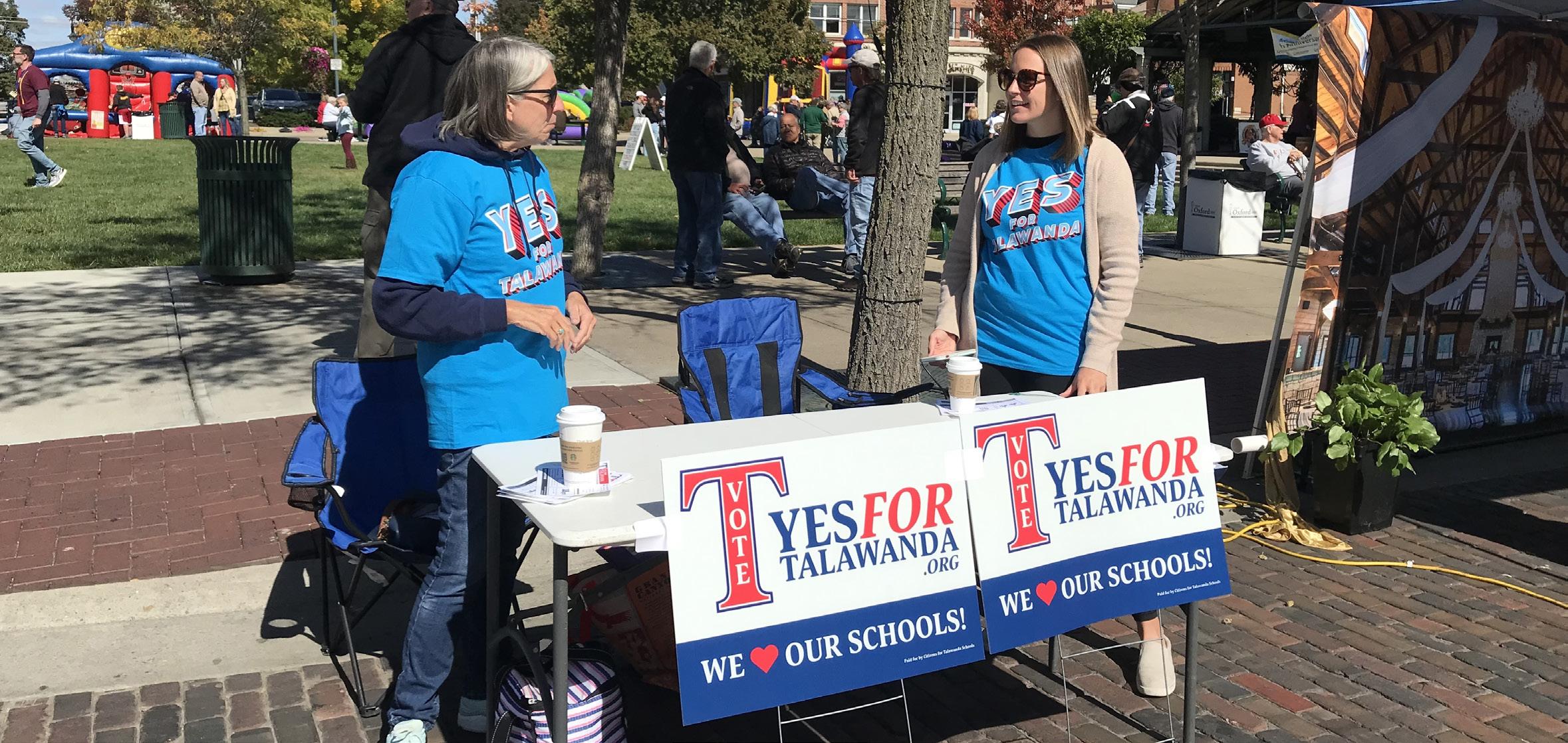
“If you’re looking at a deficit, there’s only three ways to solve that: make cuts, increase revenue or do a mix of those two things,” Morris said. “[TSD] has been making cuts, and it has proven to be not enough.”
Nicole Baldwin lives in Hanover Township and remembers when TSD passed the income tax levy in 2004. Baldwin, who has two chil dren attending Marshall Elementary School in TSD, said she doesn’t re member the exact amount her taxes increased, but she is hesitant to vote for the upcoming levy.
“I’m concerned on the taxes and how much it’s going to cost,” Baldwin said. “I’m concerned on the way the money is going to be dispersed and how it’s going to be allocated.”
Meade said in the last few years, TSD has cut $4 million out of the operating budget by cutting 10.5 teacher positions, buying out older teachers to hire new teachers for less money and negotiating a smaller pay raise for teachers.
Teaching positions may be at risk without levy Meade said a large portion of the funding generated by the levy will go toward supporting teachers in TSD.
In August 2021, the TSD teachers union agreed to a 2% salary increase for the 2021-2022 school year, a 1% increase for the 2022-2023 school year and a 0% increase for the 20232024 school year.
Although Meade said TSD has not fallen into a teacher shortage, if the levy doesn’t pass, that could change.
“We’ve been able to fill up all our positions so far,” Meade said. “I do not think, down the road, that we will maintain that with a 1% [raise] and a 0% [raise].”
Jen DeBaun, who has two chil dren in TSD, is voting for the levy
Sheldon Anderson:
because she’s worried about the posi tions that could be cut without it.
“My seventh grader receives edu cational assistance services,” DeBaun said. “He’s on an IEP [Individualized Education Program] plan, and if the levy fails … they’re going to let go of teaching aids.”
Levy sparks debate of sports and extracurriculars
Another contested issue sur rounding the levy is the funding of sports.
In 2018, TSD suspended the payto-play fee for sports and other ex tracurriculars; however, if the levy doesn’t pass, the school has consid ered bringing it back.
Previously, the fee was about $150, with an additional $75 fee if the student participated in a second sport and a cap at $500 for families with more than one child participat ing in extracurriculars.
Although no official numbers have been released, Meade said the school board has been looking at sim ilar school districts, specifically Ross and Edgewood, with pay-to-play fees of more than $800 per sport.
DeBaun said she is willing to pay extra in taxes if it means her child can still participate in the activities he enjoys.
“My seventh grader who needs a teaching assistant is in cross country, and I see how important sports are for kids,” DeBaun said. “He tells me every day that he is happier running, and I don’t want him to lose that.”
Although TSD hasn’t released how much the pay-to-play fee will be, Jacob Schulte, a TSD and Miami University alum, is worried the fee will be extremely high and will pre vent students from participating in sports and extracurriculars due to financial concerns.
“As someone who remembers from a not-so-distant past, when it was just a couple of hundred dollars, for [the School Board] to be throwing around $700, $800, $1000, it almost seems like a scare tactic or some thing,” Schulte said.

Nicole Bays, a resident in Milford Township, also has two children in TSD and agrees with Schulte that the School Board is threatening the resi dents to evoke fear and garner votes, but she remains firm in her decision to vote against Issue five due to TSD’s previous spending habits.
“I would hope that people con sider that checking ‘no’ doesn’t mean you don’t care for the teachers, you don’t care for the kids, you don’t care about the community as a whole,” Bays said. “There are other options to supplement the incomes of teachers and reach fiscal responsibility with out tapping into the community’s pockets.”
Conversely, Morris hopes voters recognize the need for a successful school district and said the only way to garner enough financial support is through the passing of the levy.
“My hope is that if the Talawan da levy is successful, and we can get back to at least the cost of living in creases for our teachers in 2024, so they’re not being left behind,” Morris said.
Residents interested in finding out how much the levy will increase their taxes can verify the amount through Butler County’s Auditor’s website.
Early voting started Oct. 12, and the general voting takes place Nov. 8.
@alicemomany momanyaj@miamioh.edu
Cold War basketball player to history professor
SHR-HUA MOORE SENIOR STAFF WRITER
Many professors need to travel abroad for research. There are envi ronments that can only be found in certain countries, libraries that can only be accessed in certain cities and people that only reside in one specif ic place. There are scholarships and grants that help researchers get to these places, but not everyone can access them.
So, in 1987 when Sheldon An derson wasn’t able to get a Fulbright scholarship to access archives in Po land during the Cold War era, he had to find another way to get there.
He found basketball.
Anderson is a history professor at Miami University, but while he was pursuing his Ph.D. he used his background as a college basketball player to play in a league in Poland from 1987 to 1988 while also doing research there.
“During the night, I practiced and played [basketball],” Anderson said. “I got room and board, and more or less a visa to get in [Poland]. Then I studied my Polish real hard and did my research for a dissertation, which became my first book.”
One of the reasons why Anderson needed basketball to access archives in Poland was because the country was still controlled by the Soviet Union. He later found out this fac tored into his inability to get a Ful bright scholarship.
“I thought [I was turned down] because my Polish wasn’t that good, but in fact it was because they didn’t think I could get into the archives,” Anderson said. “I met somebody at the embassy in Warsaw when I was in Poland. She said, ‘I remember you ... We turned you down because we didn’t think the communists would let you into the archives to do your work on Cold War Poland.’”
Anderson didn’t just play basketball in Poland, though. He also played in West Germany from 1978 to 1981. During that time, he studied history at three separate universities — first Os nabrück University, then the University of Münster and final ly Ludwig-Maximilians Univer sity Munich.
Sometimes, Anderson would take goods across the Berlin Wall to his friends in East Germany.
“Under the communist sys tem in East Germany, they were kind of all poor,” Anderson said. “They had fake coffee, fake choc olate and no good wines. So I would bring these kinds of luxu ry items with me to my friends in East Germany.”
Anderson said while he nev er intentionally smuggled any illegal goods across the border, he did come under scrutiny for having some newspapers.
“One time I had some papers on the floor in my car, and that was when [the East German police] re acted,” Anderson said. “They started asking me, ‘Why do you have these bourgeois capitalist papers? What are you trying to do? Indoctrinate our East German comrades?’”
Even though basketball let him travel to and study in Cold War Ger many and Poland, Anderson said he never had illusions of becoming a professional player. He tried out for the Carolina Cougars after college and didn’t make it, so he knew his prospects weren’t great.
“I never thought to make my bas ketball career in Germany my life,” Anderson said. “I mean, come on. In basketball, at 32 you’re already going downhill.”
Anderson’s decision to pursue re search and a Ph.D. instead of profes sional basketball led to him becom ing a professor at Miami. Here, he
teaches classes on modern world his tory, diplomacy and sports history.
Anderson said living through his tory helps him teach students.
“I always see the students bright en up when I tell a story about this or that thing,” Anderson said. “Stu dents’ eyes brighten up when you’ve got some experience being at a uni versity in West Germany or traveling behind the iron curtain in the midst of the Cold War.”
Another signature aspect of An derson’s teaching is his lecturing ability. Ned Neely, a first-year uni versity studies major, said Anderson has a unique style of talking at the front of the class.
“I honestly think he’s a good pro fessor, but it’s kind of funny how he lectures,” Neely said. “He’ll be super quiet, and then he’ll say something really loud, and all the people who weren’t paying attention kind of lift their heads up.”
“I appreciate his style of manage ment,” Arnold said. “He lets us do what we want when we have to teach and gives us a lot of independence — I vastly prefer that to the more in volved nature of some professors I’ve worked with in the past.”
While he eventually became a history professor, Anderson hasn’t given up his passion for basketball quite yet.
“I saw this guy at the Rec playing basketball the other day, and I was like, ‘that’s so familiar,’” Neely said. “I went to [Anderson’s] class the next day, and it was Dr. Anderson!”
Matthew Arnold, a second-year graduate student, liked Anderson’s approach to overseeing graduate stu dents.
@hua_shr moorese6@miamioh.edu
THURSDAY, OCTOBER 13, 2022
6
stefanec@miamioh.edu
HENEBRY ACCEPTED AN AWARD FOR MIAMI’S CONTACT TRACTING. PHOTO PROVIDED BY MIAMI UNIVERSITY BEFORE SHELDON ANDERSON BECAME A HISTORY PROFSSOR AT MIAMI, HE PLAYED COLLEGE BASKETBALL IN POLAND WHILE CONDUCTING RESEARCH THERE. PHOTO BY SARAH FROSCH THE POLITICAL ACTION COMMITTEE YES FOR TALAWANDA SUPPORTS AN OPERATIONAL LEVY FOR TALAWANDA SCHOOL DISTRICT. PHOTO BY ALICE MOMANY
Hank
LILY WAHL THE MIAMI STUDENT
People say not to meet your he roes, but Miami University students did, however, with a visit from au thor, entrepreneur, scientist and Tik Tok icon Hank Green.

Speaking about science in the dig ital age, life on the internet and bridg ing political partisanship, Green was the first guest of Miami’s 2022-2023 University Lecture Series.
Green and his brother, John, started the YouTube channel “Vlog brothers” in 2007 and soon after received funding from Google and YouTube to start two educational channels: “CrashCourse” and “Sci Show.” Now, they are both New York Times bestselling authors.
Ann Haley MacKenzie, associ ate professor of teacher education, moderated the lecture. She described Green’s journey into internet fame as going “from sig figs to an icon.”
Tickets for the event went on sale at 8 a.m. on Sept. 28 and sold out in minutes. Vivian Dao, a first-year me chanical engineering major, woke up early to get tickets.
“I kept refreshing the [ticketing] website over and over again, praying
visit to Miami: from significant figures to a significant figure
for a ticket,” Dao said.
These sentiments were echoed by twins Madeleine and Grace Ames, sophomores both majoring in micro biology and medical lab science. They were unable to secure tickets and ar rived at the event an hour early to ask for overflow seating, which they were granted.
“I wish it had been in a bigger au ditorium — so many people didn’t get tickets,” Madeleine said.
For the students that were able to acquire tickets, the lecture was an hour full of laughter and learn ing. When Green walked onto the Hall Auditorium stage Oct. 3, he was greeted with a full minute of applause from the audience.
Green explained that the path to starting “CrashCourse” and “Sci Show” was paved by funds from YouTube for creators of educational content.
He and his brother are committed to giving back to their community on and off the platform, through initia tives such as their “Project for Awe some.” They also donate half of the proceeds from “Vlogbrothers,” on which they still actively post, through grants for other educational creators who do not have the funding they need.
Green spoke with The Miami Student before his lecture and elaborated on this process.
“It’s pretty impos sible to not be lever aging my success for future cool, interest ing things that I’m excited about,” Green said, “but I also have to be leveraging it for things that are about more than just me.”
During the inter view, Green said co operation over science during the COVID-19 pandemic can help bridge partisan gaps.
“You can definite ly build a career driving people to sides, but I don’t want to,” Green said.
At the end of the lecture, he re sponded to questions from about 10 students ranging from what food he would bring to Thanksgiving (“mashed potatoes”) to what it was like writing a piece for a Star Wars anthology (“very cool”).
As the event wrapped up, students were able to head to a reception af
terward in pavilions A and B at Arm strong Student Center for more indi vidual interactions with Green.
But, even as he has become more famous, Green hasn’t strayed from his interest in science and spreading education. In a TikTok for The Mi ami Student, Green described Crash Course as “the most important work I’ve ever done.”
With Green sharing plans to re-re
Oxford hosts its first-ever Oktoberfest

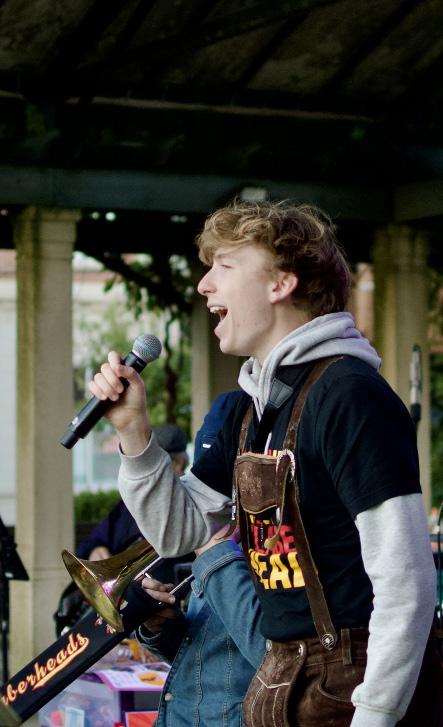
used to go with him to Munich for Oktoberfest.”
Oskinkosky and her family en joyed the beer garden and the mu sic while her kids spent time in the bounce houses.
Kate Byrd, one of the local retail ers, was there with Usborne Books & More to promote literacy. Byrd said the event turned out great, and she would be a vendor for it again.
“I always love when the com munity can come up here and be together,” Byrd said. “The Chamber [of Commerce] always puts on really good events. I do the wine festival ev ery year, so I was really excited when they decided to do this.”
Jacob Haas, a senior chemical engi neering major at Miami, said he decid ed to attend Oxtoberfest after seeing an advertisement at Skipper’s Pub.
“I feel like there’s always some
event Uptown, and I’ve never gone to one,” Haas said. “It’s my senior year so I needed to try it at one point.” Haas and two friends, including Greg Friedenberg, a senior finance major, ate some barbeque food and enjoyed the music. Friedenberg said events like Oxtoberfest are always fun.
“You get good food, and it’s a place for people to gather,” Frieden berg said.

Oskinkosky said if Oxford held another Oxtoberfest in the future, she wouldn’t want anything about the event to be changed.
“I think this one was great,” Os kinkosky said. “I think it turned out awesome. It’s great to see everybody turn out and enjoy Oxford together.”
@meta__hoge hogemh@miamioh.edu
A re-introduction to Good Sam
REECE HOLLOWELL ASST. ENTERTAINMENT EDITOR OLIVIA PATEL THE MIAMI STUDENT
Miami University students ar en’t always the most careful when it comes to alcohol.
Olivia Novotny, a junior human capital management & leadership major, knows this firsthand from liv ing in Scott Hall last semester.
“I was asleep, and my roommate came in the room at like 2 or 3 a.m.,” Novotny said. “And she was like, ‘Someone’s in the bathroom, and they sounded like they were choking while they were breathing.’”
Investigating the noise, the two discovered a girl passed out on a toi let, alive but unresponsive.
“We went downstairs to find someone, and our RD [Resident Di rector] was in her office,” Novotny said. “So she came upstairs with us
into the bathroom … She ended up calling the police.”
Authorities arrived, and soon paramedics followed, eventually get ting the girl out of the bathroom and taking her to get the necessary help. While talking with police, Novotny said they mentioned a specific uni versity policy.
“After he opened the [stall] door, he said this would be written up as Good Sam,” Novotny said.



Miami’s Good Samaritan policy,
established in the 2013-2014 aca demic year, is meant to incentivize students to find help for medical problems related to alcohol or drugs.
If a student sees a peer who has indulged too much and requires emergency medical attention, and the student reports the situation to the relevant authorities, Good Sam ensures that those involved will not have disciplinary action taken against them. It works on and off campus and is applicable for both undergraduate and graduate students.
“It’s really an attempt to have a policy that encourages students to seek help when their peers are in need,” said Kimberly Moore, dean of students. “That policy allows us to encourage students that if you need help, don’t worry about getting in trouble or the person getting in trou ble, just get them help.”
The policy, however, is not uni versally applicable.
According to the university’s FAQ page about Good Sam, “only 2.06% of all alcohol or drug-related incidents referred to the Office of Community Standards in 2020-21 were considered Good Sa maritan incidents.”

Students violating another uni versity policy at the same time, such as committing assault or possessing a fake I.D., will not be protected under Good Sam. In addition, students may only have the policy applied to them once during their time at Miami.

Students have to engage in a fol low-up process where they meet with the Office of Community Standards to discuss their situation. They are also required to take a substance use assessment and attend an education al course on the subject.
Moore said incoming students are the biggest focus when it comes to providing information about Good Sam.
“It’s big in orientation, our tar get population is really our newest members of our community to know about this,” Moore said. “So it’s defi nitely baked into the different ses sions that are done at orientation. It’s also part of the communication that our Residence Life staff does with their corridor meetings and things like that.”
Maria Vitull, director of the Of fice of Community Standards, is re sponsible for applying Good Sam to reported cases. In an email to The Miami Student, she wrote that while not all reported incidents fall under the policy, it is still important for stu dent health and safety.
“The past few academic years (COVID semesters excluded), we have processed about 65 Good Sa maritan cases per year,” Vitull wrote.
cord the CrashCourse Biology series that helped launch the brothers into internet fame, it seems this work will continue for generations to come.
The next guest in the lecture series will be celebrity chef Carla Hall on Nov. 14 at 7:30 p.m..
“Our hope is that students continue to utilize the policy as often as needed to get help for their friends and class mates.”
Studies have shown that drink ing among college students has de creased over the past few years, likely as a result of the COVID-19 pandem ic. Moore also said the amount of conduct violations processed by Mi ami is down “historically.”
However, numbers could always go back up, which is why Moore said the university is doubling down on ef forts to make students aware of Good Sam, especially post-pandemic.
“For a few years there was not a whole lot of going out, and so students weren’t paying attention to the policy as much, and we were more about ed ucating around COVID,” Moore said. “This year, we are making a concerted effort to generate another campaign to really make sure that everybody’s aware of Good Sam.”
Part of that process is clearing up confusions students may have about the policy.
“While a student who was called for only gets to use the policy once to avoid disciplinary action, a student can call for help for another student as many times as needed through out their Miami career,” Vitull wrote. “There are no limits to how many times a person can call for help.”



Vitull also specified that Good Sam applies when seeking assistance from figures of authority and can be used both on and off campus.
While first-years and sophomores are provided with the most direct in formation about Good Sam through outlets like orientation and residence hall meetings, Moore clarified that the policy is for students of all ages.
“There are a lot of times sec ond-year students might be hanging out with juniors and some people are 21, and some people aren’t,” Moore said. “It benefits the reporter and the person who’s in trouble, so it’s not a clean line based on age.”
Moore hopes that students will continue taking advantage of the pol icy when they can for the greater safe ty of Miami.
“I think they just need to know that the policy exists, and that they know that it’s there in good faith,” Moore said. “It’s not anything other than to encourage them to seek help when they think their peer or their friend or they really need it. It’s really about promoting bystander behavior and bystander intervention.”
@HollowCentral hollowrr@miamioh.edu patelou@miamioh.edu
THURSDAY, OCTOBER 13, 2022 7 Work Hard You can only get help for someone once under the Good Sam policy.MYTH MYTH MYTH MYTH MYTH MYTH Good Sam only counts if a student calls 911 or MUPD directly from an on-campus location. You can help other people as many times as needed! The reporter is protected throughout their Miami career You should ALWAYS call for help if someone needs it! Students can call 911, MUPD, OPD, an RA, RD, or the Hospital from ANYWHERE for help for themselves or someone else. Just get help! FACT FACT FACT Good Samaritan Myths & Facts Only alcohol related incidents fall under the Good Sam policy. The policy applies to cases involving drugs as well as alcohol MYTH MYTH MYTH FACT FACT FACT FACT FACT FACT
wahllm@miamioh.edu @lilymariereads
Green’s
GRAPHIC BY MIAMI UNIVERSITY
MAYOR
BILL SNAVELY AND HIS DAUGHTER DRESSED UP FOR OXTOBERFEST. PHOTO BY META HOGE
MIAMI
TELEVISION NEWS INTERVIEWS INTERNET SENSATION HANK GREEN BEFORE HIS LECTURE. PHOTO BY COSETTE GUNTER-STRATTON LOCAL BUSINESS OWNERS MADE THE EVENT A SUCCESS WITH THEIR STALLS. PHOTO BY META HOGE OXTOBERFEST FEATURED LIVE MUSIC IN OXFORD MEMORIAL PARK. PHOTO BY SARAH FROSCH CONTINUED FROM FRONT
The only thing ‘Carmilla’ film adaptations have in common with the titular character: They suck
ever’s idea it was to make her a main character for this adapta tion is now my worst enemy.
“Carmilla” (2019) gets a 6/10. It could’ve been so much more (and a lot less Miss Fon taine).
“The Carmilla Movie” (2017)
This adaptation was genu inely painful to sit through.
Apparently, it’s based on a web series that retells “Carmil la” in the modern day. I haven’t seen the web series, but after watching this movie, there’s no way I’d ever subject myself to it.
This film is what I imagine a Buzzfeed adaptation of “Car milla” would be like. It tries way too hard to be trendy and relatable, which I despise. The script made me cringe numer ous times; I actually had to stop the movie within the first ten minutes and return to it later.
The concept of a modern day
“Carmilla” adaptations in 2014, but this one was slightly better than “The Unwanted.” This time, the story is set in the 1980s, and it actually does a de cent job at capturing the gothic feel of the novella.
Lara (aka Laura) is supposed to be goth, but she’s so stereotypically edgy that it made me cringe. The dynamic between Carmilla and Lara was there, but it seemed more like they were just really good friends.
That’s the thing with most of these adaptations: they never get Laura and Carmilla’s relationship right.
In the novella, the romance is ap parent and somewhat menacing to Laura. But nearly every adaptation gets this wrong. They never show how taken Laura is with Carmilla, and they usually add a single kiss between the two just so you know they’re more than friends.
spoilers here.
CHLOE SOUTHARD STAFF WRITER
Before there was Edward and Bel la, there was Carmilla and Laura.
Yes, people have always had an obsession with vampires being beau tifully seductive creatures that woo teenage girls.
Joseph Sheridan Le Fanu’s novella “Carmilla” was written in 1872. It’s one of the earliest works of vampire fiction and the inspiration for Bram Stoker’s classic “Dracula.”
I read “Carmilla” in September and could barely put it down once I began.
Not only is Carmilla an assertive, seductive woman, but she’s also a lesbian. In 1872, being any of those things was simply unacceptable, even in fiction.
The story is narrated by Laura, a lonely girl who lives in isolation from society. Laura’s expecting the niece of her father’s friend to visit; unfortu nately, Laura’s father informs her the niece mysteriously died.
Then, a girl around the same age as Laura crashes in her carriage out side Laura’s home, and Laura’s father agrees to take care of her for a few months.
Laura recognizes the girl, Car milla, from a childhood dream. The two immediately become close, and a romance blossoms between them. Suddenly, Laura begins having night mares and falls ill.
People start getting suspicious of Carmilla, and I’ll leave it at that. No
from
Once I finished “Carmilla,” I need ed more, especially with Halloween coming up. I was surprised to see that not only is there a new adaptation of “Carmilla” set to be released in April, but the novella has been adapted sev eral times.
And every single adaptation has poor ratings — I’m talking one to two stars.
So I took it upon myself to watch whatever “Carmilla” adaptations I could find. Sit back, relax and grab some garlic and a wooden stake be cause these movies suck.
“Carmilla” (2019)
This is the most recent adaptation, so I assumed it’d actually be good. I was wrong.
This film doesn’t even mention Carmilla being a vampire, which is the entire point of the story. She also doesn’t turn up until about 40 min utes into the movie, whereas she ap pears almost immediately in the no vella. Her delayed arrival makes for a short, undeveloped romance with Laura.
Besides that, there were far too many close-up shots of bugs and worms with uncalled-for ASMR-es que squelching sounds.


Gross.
Not to mention, “Carmilla” (2019) focuses on Miss Fontaine, a minor character in the novella, more than Carmilla herself. I’ve never found a character to be more insufferable than Miss Fontaine in this film. Who
“Carmilla” is interesting in theo ry, and I believe it could be done. But this? This was the poorest execution possible — it’s almost impressive how awful this movie was.
“The Carmilla Movie” gets a 1/10 — and that’s me being generous. I’d recommend avoiding this one like the plague.
“The Unwanted” (2014)
This adaptation claims to be a Southern gothic retelling of “Carmil la,” but nothing about it is that.
Repeat after me, setting a thriller in the South doesn’t make it goth.
The time period in which “The Unwanted” occurs is unclear, but it’s certainly not the 1800s. The story is executed strangely, and if they hadn’t used Carmilla’s name I wouldn’t even count this as an adaptation.
Like “Carmilla” (2019), this film doesn’t touch on Carmilla being a vampire at all. If anything, she’s just a lesbian with some kind of blood or cutting fetish, which is slightly dis turbing.
This movie incorporates sensitive topics such as self harm in what can only be described as an icky manner. There’s a scene where Carmilla kisses Laura’s scars, and I seriously consid ered turning the film off.
The entire cast gave bland perfor mances, and to be honest, I’ll proba bly forget about this movie in a few weeks.
I give it a 3.5/10.
“The Curse of Styria” (2014)
I don’t know why there were two
Culture Convos Podcast

The characters were boring, and the only one I found myself remote ly interested in was Carmilla. If the actors gave better performances, and with some adjustments to the script, the film could definitely be better.
“The Curse of Styria” gets a 5/10.
“Carmilla” (1989)
“Carmilla” (1989) is set on a plan tation in the pre-Civil War South — an interesting choice. But the film rubbed me the wrong way. One char acter falls into the mammy stereo type, and she also practices voodoo, making the portrayal even more of fensive.
The only redeeming quality about this adaptation is Meg Tilly as Carmil la. She was one of the best Carmillas I’ve seen, so I’ll give “Carmilla” (1989) points for that. However, the chem istry between Marie (aka Laura) and Carmilla fell extremely flat; they nev er even kissed.
The film doesn’t recognize Carmil la as a lesbian at all, which is an im portant part of her character.

I don’t understand what it is with these films. They act as if Carmilla can be an overt vampire or lesbian, but never both.
I give this adaptation a 4/10 (only for you, Meg Tilly).
“The Vampire Lovers” (1970)
I thought I might actually enjoy this film, but I was mistaken. Ingrid Pitt is a decent Carmilla, and the film is actually candid about her sexuality, which I appreciated. But that’s just about it in terms of the positives.
This adaptation was underwhelm ing. It relies on gore and pretty wom en instead of staying true to the source material. There were more shirtless
women in this film than utterances of the word vampire.
“The Vampire Lovers” is dull, and while it’s supposed to be a hor ror movie, I found myself constantly checking my phone while watching it. It isn’t scary at all; it’s actually quite corny, and not in a good way.
I’m not going to lie, I already for got most of what happened in this movie.
“The Vampire Lovers” gets a 4.5/10.
Other adaptations
There are a few adaptations miss ing from my list because I couldn’t find them. One was “Carmilla” (1999), which I’m kind of glad I couldn’t find. From what I understand after read ing reviews on it, it’s basically softcore porn.
There’s also “Carmilla” (1980), which is in Polish. I’m sad I couldn’t find this film with English subtitles anywhere, because it actually looked good.
After subjecting myself to all these awful adaptations, I deserve to see a good one. As someone who has now watched nearly every known “Carmil la” adaptation, I think I have the right to say what director Ivan Zuccon’s up coming adaptation should entail.
First, he needs to be candid about Carmilla’s sexuality. She’s a lesbian, and we don’t need another watered-down, lifeless romance be tween her and Laura.
Next, Carmilla must be a vampire. There should be no glossing over this or trying to turn it into something else like “The Unwanted” did. If you’re adapting “Carmilla,” you’ve gotta stick with what makes it “Carmilla.”
Also, whoever Zuccon casts needs to have screen presence. Dull perfor mances were a common occurrence in the previous “Carmilla” adapta tions, and I can’t bear to see more.
Finally, Zuccon needs to capture the goth, dreary aesthetic of “Carmil la” the way Sheridan Le Fanu wrote it — and it needs to be at least unset tling. Ivan Zuccon, if you’re reading this, please reach out to me. I can help.
The world doesn’t need another lousy “Carmilla” adaptation. It’s been 150 years. It’s time we get the story right.
@_chloebowie_ southacr@miamioh.edu
Miami Theater’s ‘These Shining Lives’ truly shone
panes hanging in the rear made the stage appear wide open.
Its set, although sparsely fur nished, took the characters as far from their lab table as the beach.
They also sang for the radio together in front of a giant TV screen which helped narrate throughout.
Gianna Colarich, a first-year theater major who attended, felt en riched by the performance.
“I thought it was an incredible example of what collaboration and theater looks like at Miami,” she said.
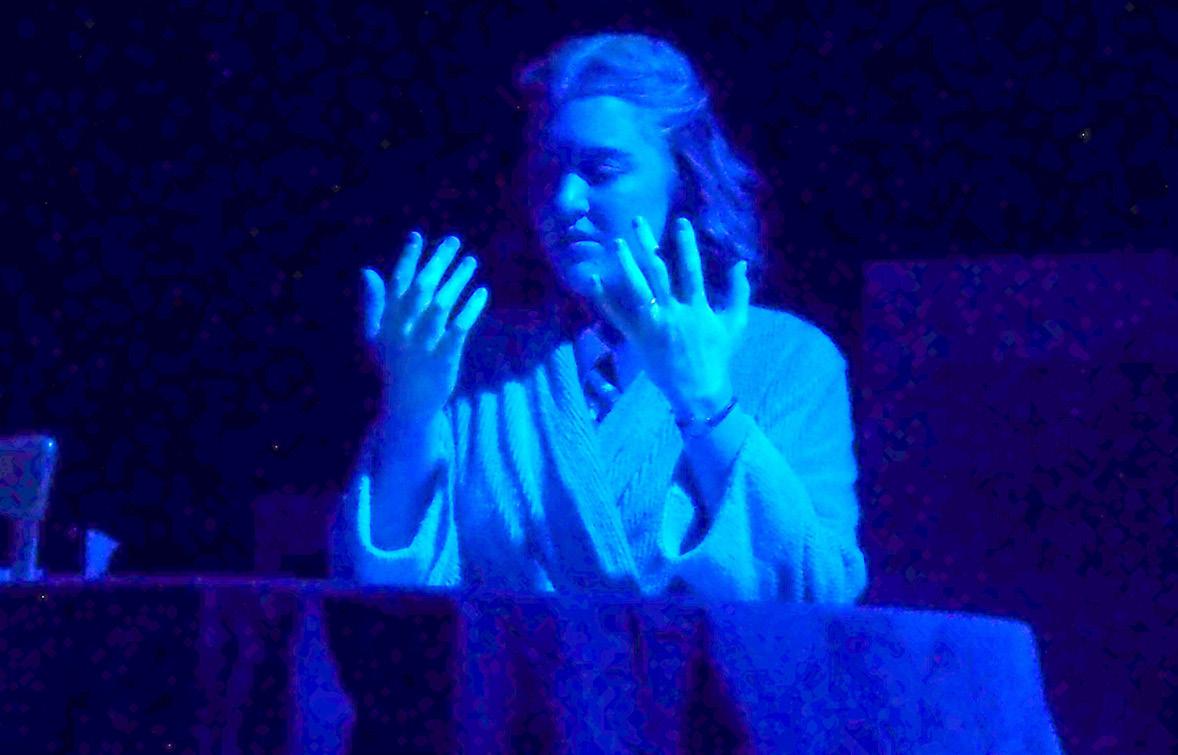
“I think you could really see the hard work that went into this production. You could tell that everybody really cared.”
Colarich studied the production in her classes.
“For one of them I was required to go and usher it,” she said. “They give us opportunities to get involved.
It’s kind of why I picked Miami, be cause I knew I was going to get a lot of experience that wasn’t necessarily performing.”
Because of the workshopping, Colarich already shared a sense of community with the play’s cast and crew.
Abby Sokol, psychology and the ater double major, played Charlotte, the most hardened and dry-humored of the afflicted women.
“Once it came time for perfor mance we all really kicked into high gear,” she said. “Having audience reactions made it a different show.”
Sokol also serves as president for Stage Left, a student-run theater or ganization on campus. She said every one of its members came to support.
Her theater politics and ethics (THE 422) course incorporated the play into the curriculum. Sokol took it upon herself to fully understand her character outside of the class room.

“The nonfiction aspect of the play kind of scared me because it was something that I wanted to make sure I got correct and did justice to,” Sokol said. “My mom and I toured Ottawa, Illinois, where the play takes place, over the summer. After having learned a little bit more about it, part of what was most rewarding was tell ing the story.”
Colarich believes “These Shining Lives” will start important conversa tions across campus about the work force.
TMS

“I was pretty blown away to see all the people I know do their thing onstage,” she said. “I was thinking maybe someday I’ll be up there as an upperclassman and there will be some underclassman looking at me like that.”
“Miami lets their students pick their [shows],” she said. “They want to do theater that promotes social change so I thought this was an amazing pick.”
entertainment GRAPHIC BY MACEY CHAMBERLIN GRAPHIC BY EMILY HOGAN THURSDAY, OCTOBER 13, 20228
stefanec@miamioh.edu
More
us... Pop
Fall Playlist Listen on Soundcloud: Listen on
Spotify:
“Is
Disney
stuck in the past?”
is the 20th episode of The Miami Student’s entertainment podcast, Pop Culture Convos. Each year, Disney hosts D23, its own personal Comic Con to show off upcoming projects and announce new ones. This year, though, it was clear that the company has little room for original works in its future. Today, co-hosts Maggie Peña and Sean Scott are joined by Reece Hollowell and Abbey Elizondo to discuss what Disney’s focus on the past means for the company’s future. Listen to our fall vibes playlist to hear what our Miami Student entertainment writers and editors are listening to! CONTINUED FROM FRONT CATHERINE (PLAYED BY TAMMY SANOW) SHOWS HER GLOWING HANDS, THE EFFECT OF RADIUM PAINT USED IN HER WORK AT RADIUM DIAL. PHOTO BY GION DEFRANCESCO
The return of allday breakfast
A non-coffee drinker’s guide to cafes in Oxford
MAGGIE PEÑA ENTERTAINMENT EDITOR
For all of the 21 years I have lived on this earth, I’ve never tried a partic ular substance to which Americans — nay, humans — are addicted: coffee.
(Just to get it out of the way, I nev er drank tea either… and yes, your as sumptions of my religion growing up are probably correct.)
I always loved the smell of the cof fee aisle in Kroger, and I never mind ed the scent of lattes and Frappucci nos wafting up the stairs when I lived above Kofenya my junior year.
And yet, though my curiosity of the supposedly-bitter drink has in creased as I’ve grown older, my will ingness to try it has stayed dormant.
smell of warm, delectable caramel. The drink is just tart enough that I enjoy it through small sips. Even if it lasts long enough to get cold, it still tastes just as delicious. A caramel ap ple cider doesn’t scratch my caffeine itch, but it does provide a tasty drink perfect for pre-gaming the pumpkin patch.
King Café - Smoothie
chocolate, this summery drink is a perfect pick-me-up in the middle of a long day of classes. It doesn’t contain caffeine, but its sweet yet sour taste makes it a good addition to a Pulley lunch or a study date.
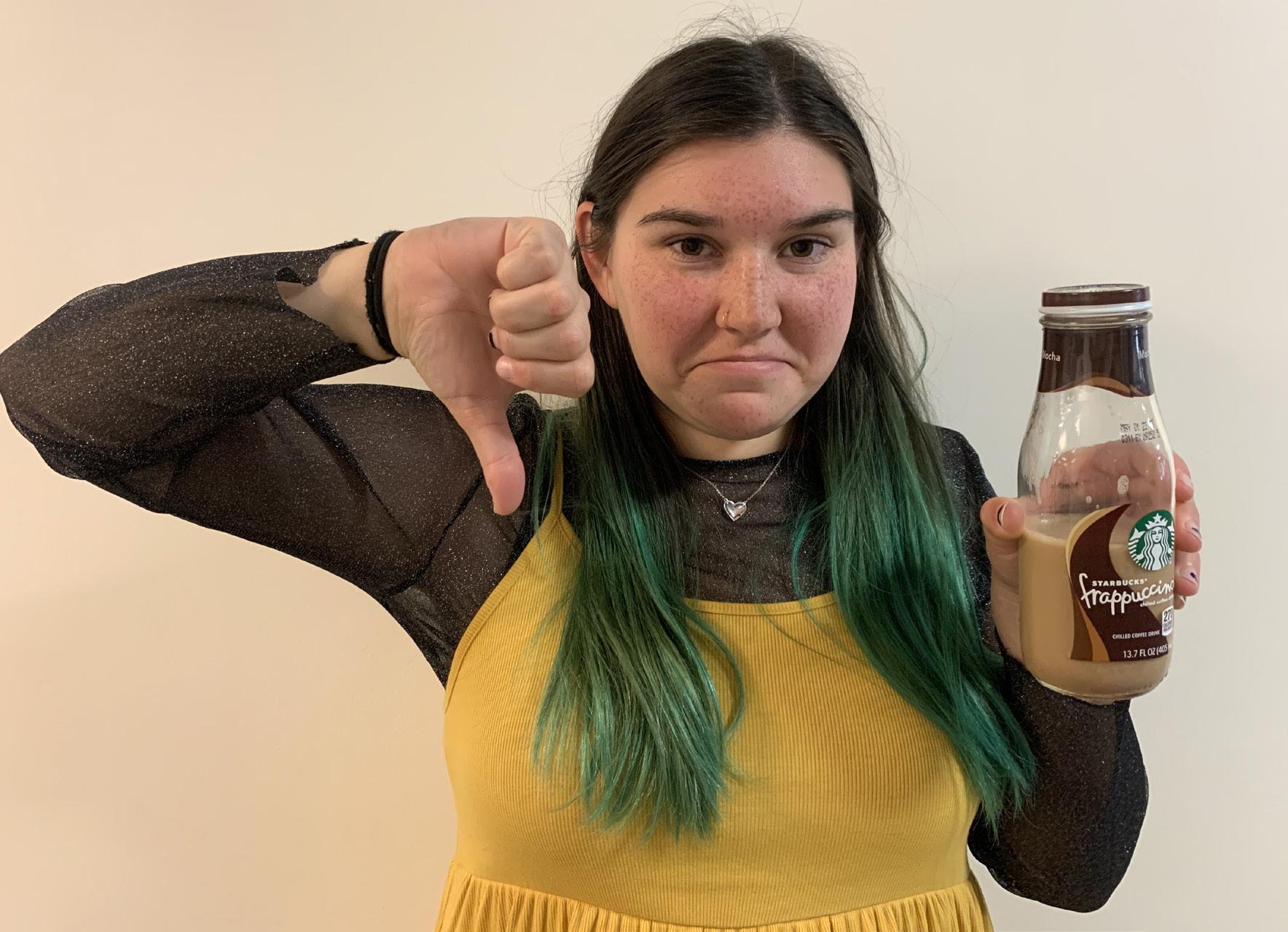 AMES RADWAN FOOD EDITOR
AMES RADWAN FOOD EDITOR
Last year, I got my friends hooked on Pulley Diner’s omelets.
Made of thin layers of perfect ly-cooked egg folded around top pings of one’s choice such as spinach, mushrooms or ham (and, of course, topped with a heaping helping of cheese), these omelets were some of the best I’d ever had. My friends and I would often head to Pulley Diner around dinnertime and order them — a salty, cheesy 6 p.m. omelet, com plete with a side of hash browns and some toast with jam.
Upon returning to campus this year, I was psyched for these omelets again. No matter how hard I tried to make similar ones at home, I could never quite achieve that Pulley’s jenais-se-quoi.
But then, tragedy: Pulley’s can celed its all-day breakfast this year with the Aramark Corporation take over of Miami dining services. Break fast was to be served, well, during breakfast time — ending at 10:30 a.m.
As someone who is rarely on-cam pus before 10, this could not have been more devastating to me person ally, and to many of my peers, who I knew to hold Pulley Diner breakfast more dear at 10 p.m. than at 10 a.m.
After nearly two months of school, however, the official Instagram ac count for Miami University’s din ing services announced in a post on Monday, Oct. 10 that they had lis tened to the student body’s wishes and brought back our beloved all-day breakfast services.
Many Miami students were clear ly thrilled, with the post racking up 119 likes by Wednesday, Oct. 10. This was over twice the number of likes as obtained the post before, which announced dining events upcoming throughout the month of October (46 likes), and the post after (52 likes), which gave further information into one such event — “Here’s the Scoop,” an ice cream event at Western Dining Hall.
If breakfast is more well-liked than ice cream on this campus, you know the student body missed their all-day breakfast opportunities.
With that being said, as with near ly everything food-related on this campus, there were still some chang es made to breakfast at Pulley Diner.
These changes have been around all semester long, but only for the ear ly-morning crowd — not for the night owls.
As someone who had not had the
chance to go to Pulley’s for breakfast yet this semester (read: I like to sleep in), I took the opportunity to grab a quick breakfast-for-dinner bite on Monday night — the old-turned-new all-day breakfast’s first day of opera tion.
Many “plain” favorites from last year, such as eggs and toast, are gone. Hash browns in their totality are no more, with all breakfast items on the GrubHub app reading, “Served with tater tots.”
Luckily, some favorites have stayed – pancakes and omelets, for instance — and new contenders have arrived to the (literal) table. Breakfast sandwiches and a tomato, avocado & turkey bacon scramble can now be found on the Pulley Diner menu.
On Monday night when I went, omelets were completely out of stock. Considering the amount of people I personally know on campus who would kill for a Pulley Diner omelet, especially on the first day back for allday breakfast, this was unsurprising.
Side note: the days of build-yourown omelet are gone, with only three pre-made options now offered: a cheddar omelet, a western omelet and a turkey sausage omelet. There goes my perfect order of mushrooms, spinach and American cheese.

At least you can still add Oreos to your pancakes. Maybe I’ll have to get those more often.
With the lack of omelets on Mon day night (which has, thankfully, since been rectified), I tried one of the breakfast sandwiches — a sausage, egg & cheese muffin, sans sausage. I am a vegetarian, after all.
It was solidly mid — my egg came over hard instead of scrambled, and I was given French fries instead of the promised tater tots, but other than these minor issues, it was a breakfast sandwich, and I ate the lot.
At 7 p.m. on a Monday, that was all I could ask for.
Will I be visiting Pulley Diner ev ery night for breakfast-for-dinner this semester? No — but at least the opportunity has returned to campus, and my late-night cravings for an om elet can finally be satisfied.
For those of you who missed the all-day breakfast as much as I did, you can now find breakfast sandwich es, omelets, scrambles & breakfast sides available all day at Pulley Diner in Armstrong Student Center. Head over there today to get your fill of a late-night breakfast snack.
Thank you, Miami Dining! Thank you, Aramark!
Now, this isn’t to say I don’t like caffeine — in fact, though part of my reason for never trying coffee stemmed from a fear of developing a caffeine addiction, I now drink Mountain Dew almost every day.
But sometimes, my tolerance for Mountain Dew falls, and I want to find another avenue for my caffeine intake. Other times I want to treat myself to a decadent dessert reminis cent of a fancy coffee concoction but absent of any actual coffee.
And thus, this listicle was born. Here, in no particular order, are my favorite non-coffee drinks to get from cafes in Oxford or on campus (plus a bonus feature: a recommendation for a drink to absolutely, at all costs, avoid).
Kofenya - Caramel Apple Ci der
Caramel Apple Cider: I love the vibes of a small-town cafe. The only problem is the obligation (and de sire) to purchase something when studying there for a prolonged period of time. So when I first looked at their menu, I was saddened to see Kofen ya had limited options for non-coffee drinkers. But! My sadness did not last long — in lieu of a hot chocolate (I can make that at home), I pur chased a caramel apple cider. I swear this drink changed my life. It comes out piping hot and steaming with the
Smoothie: I am a fiend for ice. Ask my friends — I go to Pulley Din er, sometimes out of my way, just to get ice because they have the best ice on campus (perhaps I will rank campus ice one day). Why do I tell you this random anecdote? Because King Café makes their smoothies in a way that leaves micro-pieces of ice in the mixture, and it’s my favorite treat to reward myself after a long day of classes and studying. My personal order usually includes some variation of berries (strawberries, blueberries, raspberries). But mix it up! I’m sure the flavors don’t affect the ice factor, so I really don’t see how any concoc tion of fruit could ruin that.
Cafe Lux - Hot Chocolate, Strawberry Lemonade (and bo nus - Refresher)
Hot chocolate: The hot chocolate from Cafe Lux is absolutely, 100% the best drink on campus. For context: When I go to Starbucks, and if I don’t order my usual (listed below), I go for a hot chocolate. But, much to my chocoholic mother’s dismay, I’m not a huge fan of super-chocolatey things, so I have to go through the hassle of asking them to add half the choco late, them looking at me like I have three heads and suggesting a kid’s hot chocolate and me walking away with essentially a chocolate milk. Don’t get me wrong, I love chocolate milk, but I don’t want that in place of a warm winter drink. That’s why Café Lux’s hot chocolate is so revolution ary — it comes de-chocolated. For some, this would be a weakness. For me, it represents all that I find holy in a hot cocoa beverage.
Strawberry lemonade: Cafe Lux stays winning with this drink. In complete contrast to its perfect hot
AVOID - Refreshers: Now I know I said Café Lux stays winning… but I would highly suggest avoiding its re freshers at all costs. I got the passion berry hibiscus refresher, and maybe it was just those particular flavors, but I will never know because it of fended my taste buds so much that I have sworn to never grant my pa tronage to this drink again. As I de scribed to my friends the unfortunate day this liquid attacked my tongue, it tasted worse than a La Croix, like the barista put water in a cup with some fruity decor, walked across the room, whispered “passion berry hibiscus” to inject the flavor and then served me my drink. Would 100% not rec ommend this drink, even if you are desperate for some caffeine. It would be more worth it to just fall asleep in class.
Starbucks - Strawberry Açaí Refresher
Strawberry Açaí refresher (with lemonade): When I’m tired of con suming ghastly green Mountain Dew, my second-in-command is Star bucks’ strawberry açaí refresher with lemonade and light ice. Though it has about half the caffeine as a Mountain Dew, it still packs a punch, especial ly with the tartness of the lemonade. My favorite part about this drink has to be the little dehydrated strawber ries they add; as the drink runs out, I like to eat a couple as an added treat.
Our coffee-hating Food Editor Ames Radwan has also given these their stamp of approval as the best possi ble non-coffee Starbucks drink.
Mountain Dew - my personal favorites
If you like Mountain Dew as much as I do, you’ll probably appre ciate this comprehensive list of my rankings of the flavors.
penaml@miamioh.edu @maggieloup
Once and for all: Bagel & Deli is delicious
 AMES RADWAN
AMES RADWAN
Alongside


radwanat@miamioh.edu
THURSDAY, OCTOBER 13, 2022 9 ENTERTAINMENT EDITOR MAGGIE PEÑA VISIBLY DISLIKES COFFEE PRODUCTS. PHOTO BY MAGGIE PEÑA PULLEY DINER’S RETURN OF ALL-DAY BREAKFAST HAS CULMINATED IN ALL AVAILABLE BREAKFAST FOODS SELLING OUT BY WEDNESDAY NIGHT. PHOTO PROVIDED BY AMES RADWAN FOOD
85.7% 14.3%
FOOD EDITOR In the Sept. 29 edition of The Miami Student, Food Editor Ames Radwan and Assistant Opinion Editor Devin Ankeney went head-to-head in a bagel battle of columns to determine the answer to one age-old question: Is Bagel & Deli good? Ames argued that B&D is an Oxford classic that creates community, that the preparation of bagels via steaming is not a disgrace to bagel-kind and that the B&D challenge is a unique and fun way of bringing people into a restaurant. Devin, on the other hand, argued that the preparation of steaming bagels after boiling them is not firm and is, thus, inauthentic.
this side-by-side clash of the columns, The Student additionally published a QR code linking to a poll where readers of The Student could vote on if they agreed with Ames or with Devin. These are the results, with an overwhelming tipping towards Bagel & Deli being a beloved Miami classic. Guess traditions are traditions for a reason, Devin... THE ABOVE “BAGEL GRAPH” DETAILS THE RESULTS OF LAST PRINT EDITION’S POLL. GRAPHIC BY AMES RADWAN
RedHawk roundup: hockey impresses against ranked opponent, field hockey’s tough weekend and more
JACK SCHMELZINGER SPORTS EDITOR
It was a busy and largely successful weekend for Miami University sports. Football won a must-win game, hock ey surprised the college hockey world with a win over a ranked opponent and field hockey held its own against one of the best in the country.

Here’s how it all went down!
Hockey
The vibes around Miami hockey (2-1-1) are as good as they’ve been in a while.
There was a lot of excitement around campus for RedHawk men this year, and so far it seems like that was for good reason. This year’s re cruiting class looked really good on paper, with many talented and prov en United States Hockey League (the best NCAA feeder league in North America) players joining the squad.
The RedHawks have seen great per formances so far from key returning players, and some of those new re cruits have impressed as well.
The RedHawks were tested this weekend after winning one of two against a decent Ferris State team last week. UMass-Lowell (2-1-0) came into the series No. 15 in the country, and the RedHawks showed well.
Miami won 3-1 on Friday. Firstyears Artur Turansky and Max Du kovac scored their first career goals in this game. Dukovac, who has looked electric and is tied for the team lead in points through four games, capped off the Miami scoring with this slick backhand score.
Miami scored first on Saturday but ended up losing 4-2. But even one win against a ranked opponent on
the road is a nice achievement for a team that only won seven games last season.
Miami only has one more series before it embarks on its grueling National Collegiate Hockey Confer ence (NCHC) Schedule. The NCHC has four teams in the top 20 already, and smart money says at least two, if not three or more of the remaining four teams will enter those rankings at some point this year. Miami starts its conference schedule the weekend of Oct. 28 with a home series against No. 1 Denver, the reigning national champion.
But first, hockey travels to Buffalo, N.Y, Oct. 21 and 22 to play Canisius at the Harbor Center. Puck drops on Friday’s game at 7 p.m., and Satur day’s game starts at 4 p.m.
Field Hockey Field hockey (7-6, 3-1 MAC) took two tough losses this weekend. First, they lost 2-1 in overtime to lowly Longwood on Friday. Longwood oc cupies the bottom of the MAC stand ings and is one of the worst teams in the nation according to the field hock ey Ratings Power Index.
Senior Midfielder Luli Rosso scored the lone Miami goal on Friday. Despite outshooting Longwood 5-2 in the two overtime periods, the bad guys found the net first in the second extra frame.
After losing to one of the worst teams in the country on Friday, the RedHawks had to buckle down for a Sunday matchup with one of the best. No. 6 Virginia completed the disap pointing RedHawk weekend by beat ing Miami 2-1.
Sophomore midfielder Katherine Groff scored Miami’s lone goal with just over seven minutes left
in the game, after UVA was already up 2-0.
The team has a huge game against Kent State this weekend. After the loss to Longwood, Miami is one game behind Kent in the MAC standings, so they’ll look to hand the Flashes their first loss of the season and even things up.
The two teams play at the Miami Field Hockey Complex at 2 p.m. on Friday, Oct. 14.
Soccer Women’s Soccer (6-3-4, 2-1-3 MAC) had a frustrating week, tying Buffalo 0-0 on Thursday and Kent State 1-1 on Sunday. The ties keep Miami in a pretty good spot in the MAC standings, as only five other teams have one or fewer losses this season. With five games left to play over the next two-and-a-half weeks, it’s crunch time for Miami soccer.
The RedHawks hit the pitch next this Thursday, Oct. 14 against West ern Michigan. The game is at home and starts at 4 p.m.
Volleyball
Women’s Volleyball (6-11, 1-5 MAC) continued its disappointing season last weekend.
The RedHawks got swept twice in road matches — one by Western Michigan on Friday and another by Northern Illinois on Saturday. At 1-5, Miami is sitting second-to-last in the MAC East and would need a miracle to have a chance at a championship this year. That said, they’re only a third of the way through their confer ence schedule, so there’s still time to turn it around.
Miami survives late comeback from Kent State in Homecoming game
EDWARD ORZECH STAFF WRITER

Miami is leading Kent State 27-24 with just over a minute left in the fourth quarter. The game should be over, Miami has dominated all game. But the Golden Flashes rallied for 10 un answered points in the final quarter.
Now it’s 4th and 6 with Miami’s offense on the field. The ball is on the Kent State 46-yardline.
Coach Chuck Martin and the RedHawks face an agonizing decision.
Miami could kick a field goal and give Kent State an opportunity to stage a comeback. Or they could go for it. If they get the first down, the game is over. If the Golden Flash defense makes the stop, they’ll have prime field position to make a field goal to send the game to overtime.
This situation feels all too similar.
Last season, the RedHawks scored 18 points in the fourth quarter to force overtime against this same Kent State team.
The Golden Flashes scored seven points in their first overtime possession. In Miami’s pos session, star quarterback Brett Gabbert needed just one play to complete a pass to Jalen Walker for six points.
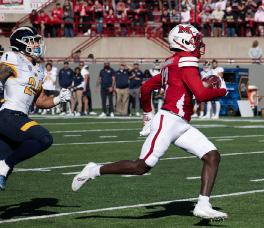
Miami faced a decision. Settle for the extra point and extend overtime, or put everything on the table and go for two.
The RedHawks went for two. Gabbert’s pass failed to find the end zone, and Kent State won.
This situation is slightly different.
The biggest factor is Gabbert. He hasn’t played since week one because of a shoulder in jury.
This time freshman quarterback Aveon Smith, known more for his legs than his arm, will have to make the pass to win the game.
Coach Chuck Martin said the decision was an easy one. Miami’s defense was slowing down, and Martin saw an opportunity to ice the game.
“We had a good drive going, we had momen tum,” he said.
Smith dropped back and threw a quick pass to tight end Jack Coldiron who picked up 16 yards and a first down. Smith kneed the ball on the last play to end the game in a 27-24 victory.
Smith said he was happy Martin gave him the chance to go for it. He said he knew what the play call would be because the team had been setting it up all game.
“I knew it was gonna be a good play,” Smith said. “I just had to be ready to execute as a team and as an offense.”
The bold play finished off an excellent bounceback performance for the Miami squad. After upsetting Northwestern on the road, the
team fell short against Buffalo. The team had to shift focus to shutting down Kent State.
Last year, the RedHawks defense allowed 303 rushing yards to the Golden Flashes. Mar tin said the focus for this matchup would be to prevent the run at all costs. The strategy worked. Miami allowed only 109 rushing yards.
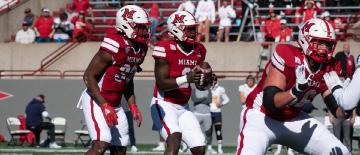
“We’re not gonna let them get their heads up running the ball,” Martin said.
A big part of the defense’s success was defen sive back Matthew Salopek, who racked up nine tackles and two sacks in the effort. He said his teammates and game plan helped the RedHawks take home the win.
“We got a bunch of confident dudes, and we had a great game plan,” Salopek said.
As for the offense, Smith had a much-needed bounceback game after disappointing outings the past two weeks. He went 9/14 passing for 179 yards and one interception while picking up 71 more yards with his feet.
The best pass of the day for Smith was when he connected with Miles Marshall for 76 yards in the first quarter. Tyre Shelton scored a two yard touchdown on the next play. Smith said the game wouldn’t have been close if he hadn’t missed a few passes.
“If I hit all those [passes], that game’s not even close,” he said. “You gotta get better and keep executing.”
While the offense and defense performed well, special teams put the RedHawks over the top. Caiden Woullard blocked a Kent State field goal attempt on their first drive of the game. Dom Dzioban averaged 44.2 yards in his five punts and Graham Nicholson hammered 45 and 49 yard field goals. Martin said having a kicker like Nicholson helps the team succeed.
“It’s just the confidence to send him out there,” he said. “We don’t even blink. We send him out there.”
The RedHawks continue MAC play at Bowl ing Green, Saturday, Oct. 15, at noon.
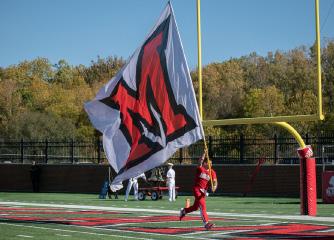
The Return of RedHawk Men’s Basketball in the 22-23 Season
JON SCHOOLEY THE MIAMI STUDENT
What to Expect this Season
Last season the Redhawks proved to be competitive in non-conference games going 6-6. Some notable matchups: Miami Univer sity fell short to Cincinnati on Dec. 1 at Millett Hall in the final seconds 59-58. They also had a standout performance against Georgia Tech on Nov. 9, winning 72-69.
Conference play proved a little more diffi cult. Miami concluded the regular season with a mark of 8-12, before suffering a First Round elimination in the MAC tournament at the hands of Kent State 85-75.
Hope is on the horizon this season, as the Redhawks return seven players who will com bine with seven new recruits to form what we all hope will be a championship ball club this winter. Our Redhawks open up the season with 11 non-conference matchups.
Some exciting opponents include Geor gia on Nov. 14, Indiana on Nov. 20, and Cin cinnati Dec. 14. All three of those games are away. The Redhawks start conference play on Jan. 3, traveling to Central Michigan. Their home opener at Millet Arena is Nov. 7 against Evansville.
New Additions
Head Coach Travis Steele enters his first season at Miami.
He was the former head coach at Xavier University with a final mark of 70-50, proving that he knows how to develop a competitive team and successful program. You can expect Steele to bring a new type of energy to this young team.
“Number one is we compete at every mo ment. Number two we carry our brother, which is being invested in your teammates both on and off the court,” Steele said at his first press conference. “Third one is we em body undeniable confidence, which is having swagger, having that belief. And the fourth thing is strive for magus, which is basical ly striving for more, constantly having that growth mindset.”
After being hired in early April, Steele wasted no time bringing in seven new play ers. The new signees are Mitchell Rylee, Bil ly Smith, Ryan Mabrey, and Jaquel Morris. Miami also acquired Anderson Mirambeaux, Julian Lewis and Morgan Safford through the
transfer portal.
Steele brings a different style of play to the table compared to his predecessor at Miami. His philosophy focuses on unselfish play, and during his time at Xavier he was a firm believ er in man defense. Likely, we will see the same philosophies come through this season. It will be exciting to see how this new team comes together considering the short time frame for Steele and the new recruits to find their collective identity. Many are optimistic this new brand of Miami basketball will result in a deeper run in the MAC tournament behind Steele.
Returning Playmakers
Fifth-year guard Mekhi Lairy Mekhi Lairy is the player to watch this year for the Redhawks.
Lairy is returning with most minutes played from last season. Some of his most memorable performances last season include: a season high in points with 28 against Buffa lo, and tallying 4 steals in a game twice versus Akron and then Central Michigan. Lairy will likely be leaned on again this season after leading last year’s Miami team on both ends of the floor in steals with 40, in addition to hand ing out 109 assists and putting up 435 points.

Junior forward Kamari Williams
Kamari Williams played a significant amount of minutes last season, starting 9 games as a sophomore. He went 80% from the free throw line going 26 of 32.
Expect to see Williams maximize his po tential with Steele’s new offense. Steele’s un selfish ideology of constant ball movement should allow widespread scoring opportuni ties and more shot attempts. This will lead to more attempts at the charity stripe, which is where Williams thrives.
Watch out for this Recruit
First-year Mitchell Rylee was a standout player in high school. Mitchell attended Covington Catholic and led them to a 24-4 record and a District Championship. He averaged 16 points and 9 rebounds while achieving All-State Honors. I expect the 6 foot 8 center to grow into a reli able role player for Miami throughout the next few seasons.
THURSDAY, OCTOBER 13, 2022sports10
schmelj2@miamioh.edu @jackschmelznger
@edward_orzech orzeched@miamioh.edu
jschool_22 schoolj2@miamioh.edu A CHEERLEADER FLIPS WITH JOY DURING MIAMI’S VICTORY OVER KENT STATE THIS WEEK END PHOTO BY JESSICA MONAHAN IT WAS A BUSY AND LARGELY SUCCESSFUL WEEKEND FOR MIAMI UNIVERSITY SPORTS PHOTO BY JESSICA MONAHAN FIFHT-YEAR GUARD MEKHI LAIRY SIZES UP AN OPPONENT IN A GAME LAST SEASON PHOTO BY JESSICA MONAHAN
AVEON
SMITH AND MILES MARSHALL CONNECT FOR A 76-YARD PASS PHOTO BY JESSICA MONAHAN AVEON SMITH LED THE REDHAWKS TO A CRUCIAL WIN AGAINST KENT STATE THIS WEEK PHOTO BY JESSICA MONAHAN
Miami Sports Schedule
Football
Oct. 15 at 12 p.m. Miami
@ Bowling Green
Oct. 22 at 3:30 p.m. Miami
Western Michigan Hockey
he reached out to Israel “Izzy” Woolfork, who coached in multiple positions at Miami from 2013 to 2021 and was the wide receivers’ coach for the final three of his years in Oxford. Woolfork, who is now a part of the offensive coaching staff for the Cleve land Browns, helped recruit Hippen hammer out of high school.
Hippenhammer described his relationship with Woolfork as an in strumental part of his decision to at tend Miami.
“When I was leaving Penn State, I hit [Woolfork] up and he was like ‘yeah we’d love to have you,’” said Hippenhammer said. “Even though I went to a different school coming out of high school, we just always kept a close relationship and when it was time for me to leave Penn State I reached out to him.”
Now, Hippenhammer leads the RedHawks receiving core with 314 yards and four touchdowns through his first six games this season.

According to Hhead football Ccoach Chuck Martin, Hippenham mer is filling a key role left vacant by Jack Sorenson, who led the Red Hawks receivers last year, this sea son. Last year, Sorenson became the third Miami player ever to surpass 1400 receiving yards in a season. He made first team all conference and Hippenhammer made second team.
“Whatever [Hippenhammer] touches he can just do,” Martin said.. “He had a great year last year. This is kind of his time to take over that main main role even though he was a huge part of what we did a year ago and the success we had. ,” said Martin. “He’s just good at everything. He’s a good
route runner, he’s really really fast, he’s really good at catching the ball. He’s really smart. Like I said, he’s so talented.”
Hippenhammer’s athletic excel lence extends far beyond his success on the football field, however. In ad dition to football, his long athletic re sume includes several years of hock ey, soccer, and baseball growing up. It also includes four years of collegiate baseball.
He said that his decision to be a dual sport athlete was influenced by advice from his dad.
“Throughout high school I real ized I was probably good enough to play at the next level,” Hippenham mer said.. “My dad always told me to just play both as long as I could and I just took that literally.”,” said Hip penhammer.
He highlighted that baseball was an important piece of the college de cision puzzle for him.
“When I was getting recruited, primarily all my offers were football offers but I wanted to play baseball so I made sure that at whatever school I was going to, baseball was part of the deal,” he said.. “I ended up being able to play football and baseball at Penn State, which was awesome.”,” he said.
Despite the difficult hours re quired to be a two sport athlete, Hip penhammer described the experience as a positive opportunity that he was proud of himself for taking on.
“I impressed myself, honestly. I’m not the type to brag about myself a lot, but I give myself a lot of credit for doing that and keeping good grades at the same time,” he said. “I got to meet personalities from the football team and the baseball team and be around two different environments and my
biggest thing was just staying on top of my schoolwork, which I did. It was fun.”
Not only did he impress himself with his ability to juggle schoolwork and two sports, but also his coach.
“So few athletes are good enough for Division I, but he’s Division I at both,” said Martin. “I always marvel at kids that have all the boxes.”
After three seasons at Penn State and one at Miami, Hippenhammer decided it was time to wrap up his baseball career
“My last year of baseball here, I didn’t really do that well,” Hippen hammer said. “So I was like, alright, at some point I’m gonna have to pick one because I’m not Bo Jackson, where I can just go back and forth whenever I want. I think it was time for me to pick one, and after I realized I didn’t have such a good year base ball- wise I was like, ‘okay, it’s time to hang it up and just put all my beans in football.’”
Martin saidys that he has seen Hippenhammer’s transition away from baseball reflect on the football field. He attributed this to the new found ability to devote the entire off season to football.
“He is stronger and faster. He’ll be able to handle more,” Martin said. “He was already really good but when he puts his foot in the ground he’s just a little quicker, and he’s just bigger.”
In addition, Martin said Hippen hammer’s leadership and character would be a big part of the team’s suc cess going forward.
“He’s a good leader for us. He works his tail off. He’s just such a nice person,” Martin said. “He never gets down on a teammate. He doesn’t have that in him to be mad at some
body. He’s an awesome player and an awesome person.”
For Hippenhammer, success this season is about helping out young Quarterback Aveon Smith, who took over for starter Brett Gabbert after an early season injury.
“I’m proud of Aveon for stepping up. He’s got things to work on and so do we,” Hippenhammer saidsaid Hippenhammer. “I think for us as receivers, it’s our job that, since Brett [Gabbert] is not with us at the mo ment, that we have to do everything we can to make Aveon [Smith] right, whatever the situation is.”
He added that he has a lot of faith in the young quarterback.
“I think he’s doing a phenomenal job and I’m excited to see him suc ceed with us, because I believe he can succeed,” Martinhe said.
Once the season comes to a close, Hippenhammer is uncertain what role football will play in the future. While he did not rule out playing pro fessionally, he stressed that his main focus for now is solely on college.
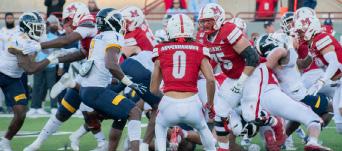
“I’m kind of just focused on do ing my thing here and then if it takes me there it takes me there,” Hippen hammer said.. “I’m really not worried about it right now. If it’s meant to be it’ll happen.”,” he said.
For him, this season is about fin ishing strong and enjoying his last moments with his team.
“It’s kind of emotional just being out there with all these people, just re alizing it’s kind of over in six months for me,” he said. “But I’m not really worried about that too much. I’m just tryna have fun with these guys.” stevenl7@miamioh.edu
Statue of Sean McVay to be erected among Cradle legends
And he’s only 36 years old.
McVay’s will be the eleventh statue on the south side of Yager, joining Paul Brown, Weeb Ewbank, Bo Schembechler, Earl Blaik, John Harbaugh, Ara Parseghian, John Pont, Thomas Van Voorhis, Carm Cozza and Paul Dietzel.
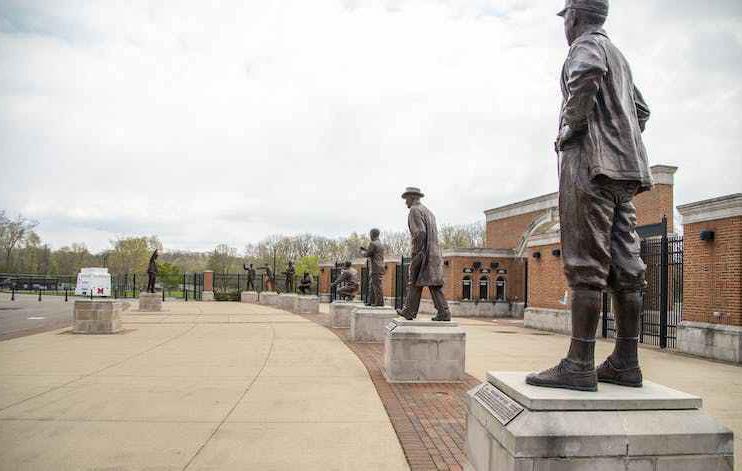
Miami’s coaching lineage is gen uinely remarkable. Woody Hayes coached at Miami and won five na tional championships at Ohio State and he doesn’t even have a statue. Same for Sid Gillman, who many call the father of the modern passing game.
McVay’s Super Bowl win made Miami the only university with three former football alumni to win Super Bowls as head coaches, joining Ew bank and Harbaugh.
world soon after as a coach. In 2017 at 30 years old, McVay became the youngest head coach in modern NFL history when he was hired by the Los Angeles Rams. In his first season, he was named NFL Coach of the Year.
The next year, he brought Jar ed Goff and the Rams all the way to the Super Bowl where they lost 13-3 against the Patriots and the greatest quarterback of all time. In 2022, Mc Vay became the youngest head coach ever to win the Super Bowl.
Work on McVay’s statue is al ready underway.
“We are in the process of working with Coach McVay on planning for the creation and installation of the statue and hope to celebrate this ad dition to campus soon,” said Miami spokeswoman Jessica Rivinius.
Sean McVay will be the latest coaching great honored with a stat ue outside Yager Stadium, Miami
Rushing
Receiving
When his Los Angeles Rams won the Super Bowl last year, McVay ce mented his future status as a legend.
Sean McVay was never a star at Miami. In three seasons as a receiver he recorded 39 receptions, 312 yards and no touchdowns.
He made his mark on the football
schmelj2@miamioh.edu @jackschmelznger
Oct. 21 (7 p.m.) and 22 (4 p.m.) Miami
@ Canisius
Field Hockey
Oct. 14 at 2 p.m. Miami Kent State
Oct. 21 at 3 p.m. Miami
@ Central Michigan
Oct. 23 at 12 p.m. Miami
@ Michigan St. Soccer
Oct. 13 at 1 p.m. Miami Western Michigan Oct. 16 at 1 p.m. Miami
@ Toledo
Oct. 20 at 7 p.m. Miami
@ Bowling Green
Oct. 23 at 1 p.m. Miami Northern Illinois
Volleyball
Oct. 14 (4 p.m.) and 15 (5 p.m.) Miami Eastern Michigan
Oct. 19 at 6 p.m. Miami
@ Bowling Green
Oct. 22 and 23 (times TBA) Miami
@ Central Mich
field hockey stats
Miami soccer
Miami volleyball stats leaders (through
games)
Passing Aveon Smith (55/105, 644 yards, 6 touchdowns, 4 interceptions)
Keyon Mozee (77 rushes, 353 yards, 1 touchdown) Aveon Smith (49 rushes, 259 yards, 3 touchdowns) Kevin Davis (32 rushes, 200 yards, 2 touchdowns) Tyre Shelton (28 rushes, 133 yards, 3 touchdowns)
Mac Hippenhammer (22 receptions, 314 yards, 4 touchdowns) Miles Marshall (5 receptions, 119 yards) Jack Coldiron (11 receptions, 111 yards, 1 touchdown) Defense Interceptions: Ryan McWood, John Saunders Jr., Jacquez Warren, Eli Blakely, Yahsyn McKee Sacks: Matt Salopek (3.0), Caiden Woullard (3.0), Ty Wise (2.0), Corey Suttle (1.5) Tackles for loss: Salopeck (5), Woullard (4), Wise (4), McWood (3) Tackles: McWood (53), Salopek (50), Michael Dowell (41), Saunders (29), Warren (28)
JACK SCHMELZINGER SPORTS EDITOR
University President Greg Crawford announced during his State of the University address on Sept. 28.
THURSDAY, OCTOBER 13, 2022 11
11 LEGENDARY MIAMI COACHES ARE ALREADY HONORED WITH STATUES BEHIND YAGER’S SOUTH END ZONE PHOTO BY ZACH REICHMANN HIPPENHAMMER ENJOYS AUDIENCES AT AWAY GAMES FOR THE ROAR OF THE CROWD. PHOTO BY JESSICA MONAHAN Mac Hippenhammer is making the most of his final season at Miami CONTINUED FROM FRONT Miami Football Stats Leaders EAST Buffalo Miami BGSU Kent St. Ohio Akron WEST Toledo Ball St. Easter Mich. Western Mich. Central Mich. Northern Ill Conf 3-0 1-1 1-1 1-1 1-1 0-2 CONF 2-0 2-1 1-1 1-1 0-2 0-2 Overall 3-3 3-3 2-4 2-4 3-3 1-5 Overall 4-2 3-3 4-2 2-4 1-5 1-5 1-1 Mid-American Conference football standings Miami
leaders (all through 13 games) Player goals assists #9 Claudia Negrete Garcia 9 2 #13 Paula Peña Martinez 9 0 #55 Macy Mchale 1 9 #18 Luli Rosso 1 7 #16 Katherine Groff 2 2 #28 Isabelle Perese, goalie (7 wins, 71 shots faced, 15 goals allowed, 1.11 goals per game)
stats leaders Player games goals assists #22 Makenna Morrison 12 5 0 #11 Camber Hayes 13 1 7 #15 Norah Roush 13 3 0 #33 Madeline Schlecht 12 3 0 #32 Taylor Hamlett 6 2 0 #1 Izzie Vaccari, goalie (13 games, 54 shots faced, 10 goals allowed, .77 goals per game)
16
Miami volleyball stats leaders (through 16 games) Kills: Allyson Severance (190), Ellie Hanson (178), Abby Stratford (96) Assists: Hayden Hicks (388), Lydia Harper (163), Gracie Norris (77) Digs: Brooke Jackson (181), Ellie Hanson (166), Allyson Severance (140) Blocks: Maggie McCrary (9), Gentry Warrick (4), two tied (3)
style
Fashion 101: Lesson 2
JACK SAMPSON THE MIAMI STUDENT
My name is Jack Sampson, and this is the second installment of the series where I teach you how to develop a personal fashion sense. I am by no means an expert in fashion, nor am I the best dressed person in the world. I am simply someone who is comfortable with how they dress and wishes to help out anybody else who wants to get to that point as well.
If you did not read the first article, I highly urge you to, as it will allow you to better prepare for the rest of your journey into fashion. In it, I gave three simple tasks that you can do: clean out the clothing you do not wear from your closet, find your measurements and find content creators or characters from media who dress in ways that you wish you did.
Ok, boring introduction done. Time to move on to the next step and one of the most important: finding what style suits you best.

Some might be asking themselves, “How do I know if there’s a style that fits me?” The answer is one of the most beautiful parts of fashion: there are so many different styles, some similar, some could not be any more different. The point is that there is such a wide range that one is bound to catch your eye.
The not-so beautiful part of that answer: there are so many different styles that I cannot physically fit them into one article. But this is not a 300-level fashion theory course, so we don’t need to worry about naming every single style in existence. All you need to know is that most of these styles are just different branches of a couple main styles.
The first one we will talk about
is probably the most recognizable: Streetwear.
Streetwear is all about maximizing comfort while also looking fresh. Currently, streetwear is all about “the baggy”: oversized shirts and top pieces, baggy pants (normally jeans or cargo pants), and flashy sneakers.
A content creator I personally think does a fantastic job with this style is @k2sneaks on Instagram (85.4k followers) and TikTok (with 484.8k followers). Another creator who creates fantastic streetwear outfits is @s_xx_24 on Instagram (72.5k followers) and @greedglory.1993 on TikTok (9.3k followers). They both provide great examples of how, at least in my opinion, this style can look at its peak. The clothing they wear fits them perfectly and the way they construct their outfits feels like a form of art. I have drawn very heavy influence from both of these creators
by referring to outfits of theirs when trying to make my own.
Another major focus of current streetwear is vintage clothing. The faded and distressed look on a lot of clothing, especially pants and t-shirts, can make for an extremely clean looking outfit.
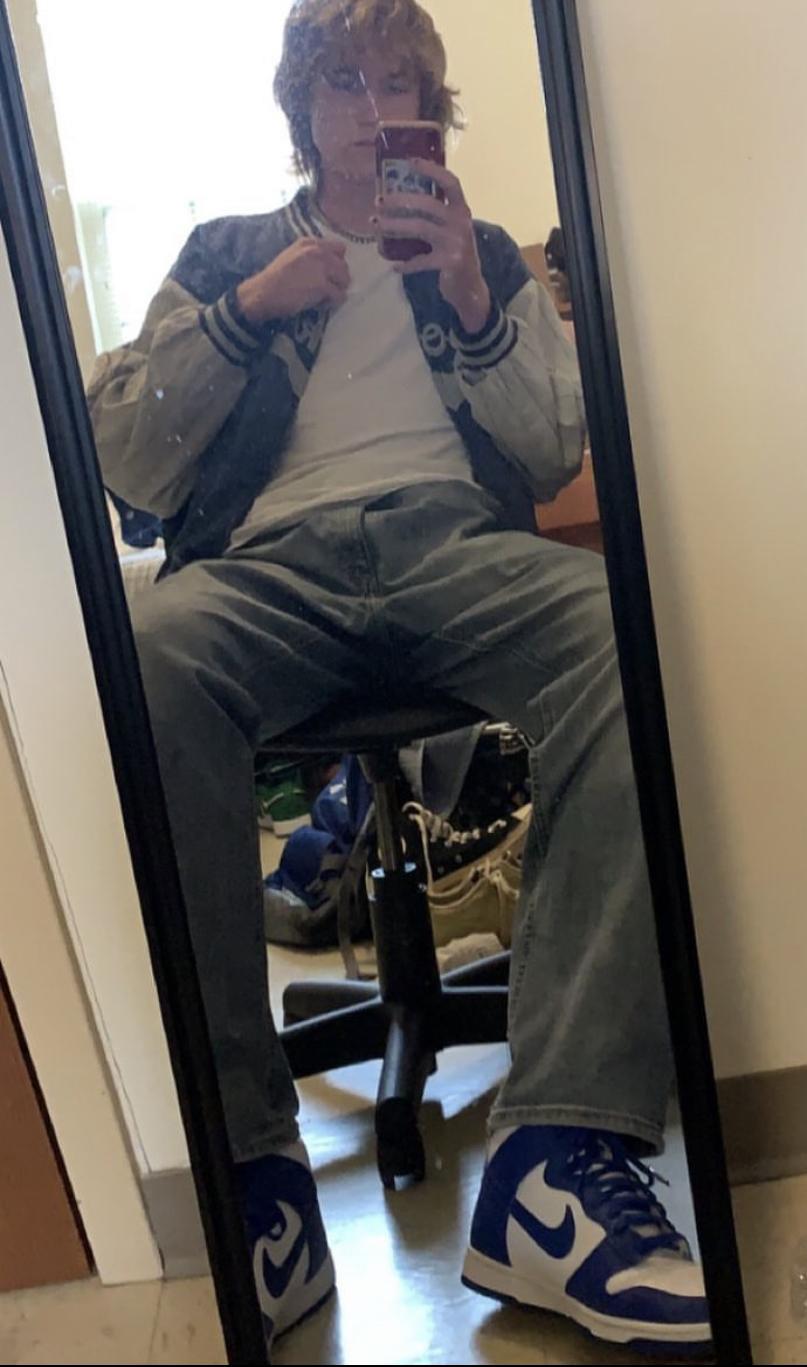
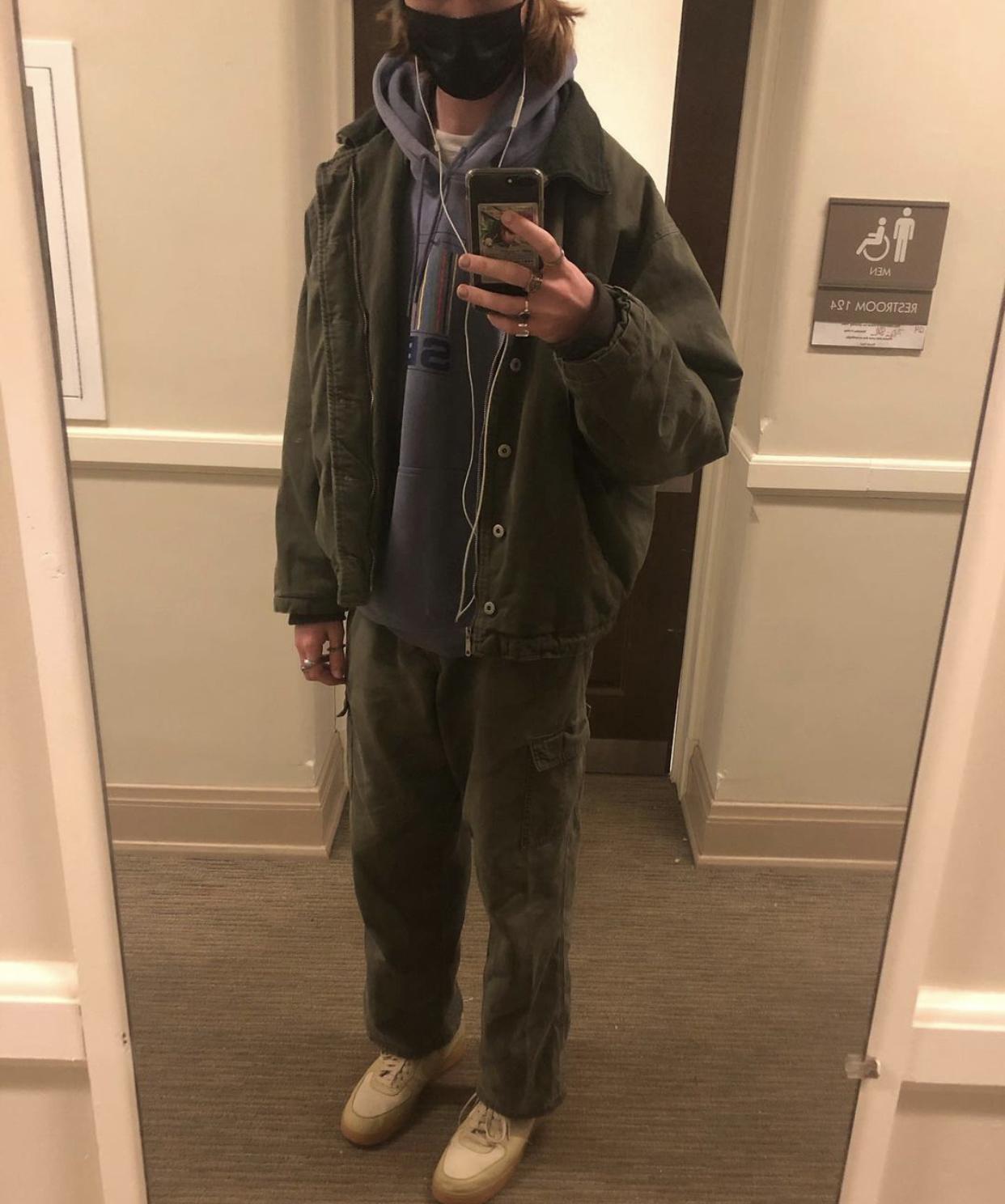
Streetwear is heavily influenced by trends, which come and go in cycles. Currently, we are experiencing a very similar trend that was present in the ‘90s, so now there is a large market for vintage clothing. This vintage MV Delaware sweatshirt is an example of the vintage look. Its faded color gives a much different look than the original coloring would have, and its measurements would allow for the desired oversized look. There are also many vendors who sell clothing that is made to look vintage, such as Urban Outfitters.
The nice thing about streetwear
is its widespread presence in pop culture and media, so inspiration will be readily available. Although it is not my main style as of present, I still continue to dress like this occasionally, partially because of the comfort that it gives but mainly because of how fun it is. I definitely urge you to try experimenting with this style!
Fashion is back: the craziest fashion month
way for more technological innovation in the fashion field. After only 10 minutes, Hadid walked the runway in the spray-on dress and closed the most talked about fashion show. This moment will surely remain in fashion history.
Fashion runways have finally returned to glamor and innovation. For years, fans of high fashion have seen the same three things: neutrals, monotonous model walks and predictable trend cycles.
This month has exceeded all expectations, a sight for the many who have remembered what the 90s and early 2000s brought: creativity.
Starting off with the most celebrated runway this season. A combination by the designer brand Coperni and supermodel Bella Hadid, the closing garment was created right before the audience with only a specialized spray. According to CNN, Hadid walked the runway in nude underwear before the creator of the fabric spray, Manel Torres and his team, sprayed the model to create a wearable dress.
This technology is called Fabrican, a spider web-like spray that combines fibers and molds clothing to the wearer. The official Fabrican website reports, “Spray-on fabrics liberate product and apparel designers from the constraints imposed by the need for cutting to size, stitching, and fitting of traditional materials.”
Dating all the way back to the early 2000s, this spray’s popularity has escalated during this show which now paves the
Alongside Coperni, many other shows have shown extravagance and creativity in other ways. During Gucci’s show, the brand casted pairs of identical twins to wear matching garments down the runway. Walking side by side, 68 pairs of twins were scouted by the brand during Twins Day, a convention in Twinsburg, Ohio.
The entire show was sectioned off into two parts, the two sides of the room thinking that there is only one model walking the runway. Each opposing side of the audience did not see that there was another person walking side by side, as a panel was separating the matching pairs. During the last moments of the show, the panel was lifted for the audience to witness the truth behind the illusion.
Another shocking runway walk was the staging of Balenciaga’s runway. The brand, known for extravagant and outlandish styles, had the models walk a mud runway. Denma Gvasalia, the designer behind this showcase, said that the runway is “a metaphor for digging for the truth and being down to Earth.”
Among the designers’ visions were also muses who walked down the runway. From ‘90s supermodel Linda Evangelista closing Fendi to Paris Hilton closing the Versace show in a pink diamond dress and matching hot pink veil, the runways were
packed with celebrities showcasing their favorite designers’ pieces.
And lastly, there was chaos. Both organized and disorganized, models usually have a few stumbles here and there. But this season, the fashion label AVAVAV made each of their models fall down the runway. Each fall was captured midway by photographers, as one of the most eye-catching pieces — the gigantic fur boots — were on full show.
Fashion month may have ended, but the creative energies of each brand has made the experience of both front row goers and at-home fans interesting this year. As new expectations are getting set, will there be more innovative takes or will it disappoint? Only time will tell.
sampsojw@miamioh.edu THURSDAY, OCTOBER 13, 202212
Are you a: • writer • photographer • designer • or illustrator? Visit miamistudent.net to Join the TMS Team!
JACK’S CASUAL STYLE CONSISTS OF STREETWEAR: CARGOS AND OVERSIZED SHIRTS ARE STAPLES IN HIS CLOSET. PHOTO BY JACK SAMPSON
MIHAELA MANOVA STYLE EDITOR
manovamd@miamioh.edu
JACK
SAMPSON’S DAILY OUTFITS BEFORE CLASS AND ON CAMPUS. PHOTO BY
JACK SAMPSON
The Silly, The Goofy, The Quirky Jaywalking Lads.
STEFANOS GEMELAS
THE MIAMI STUDENT
We’ve all been on our way to class before and walked out into the crosswalk utterly ignorant of our surroundings. This not only halts traffic for the 20 cars unfortunate enough to be driving up High Street but also puts us into unnecessary danger.
Commonly called Jaywalking, Frogger, Dodge-Car or Automotive Chicken, it’s a close second in danger and fun to drunk driving. We’ve all seen it; the poor driver, caught in the middle of the intersection, starts to have a panic attack when 10, maybe 20 more people walk out into traffic and the mob mentality takes over.
Is it solely because we’re distracted? Being hypnotized by Instagram and watching freshmen hurt themselves on the Barstool Miami page is a solid reason, but our whimsical jaywalkers aren’t always that distracted, so maybe not.
How about a lack of road safety law knowledge? Not everyone knows to look both ways before crossing, but less cynically, not everyone understands the nuance of a fourway stop. Maybe it’s because we’ve partaken in the juices of the Devil?
But that only accounts for roughly one half of Oxford jaywalking. There’s something I’m missing.
Research (my opinion) tells us that
jaywalking peaks at the beginning of the week, and gradually lessens as the week continues, only to rise again on Friday and Saturday nights.
Do people loathe going to class that much? I’m not qualified for this level of social commentary, but I’d think not.
Are people really that absentminded when enjoying their weekends though? I’m probably qualified to comment on this, and I’d answer with confident uncertainty.
The most confident answer I can provide then is a written gesture of indifference. Some brave souls, who I definitely talked to and didn’t just forge quotes for, said, “Traffic laws are a lie told to you by Big Crosswalk so they can sell more crosswalks,” and “The cars can hit me if they want. I’m just built different.”
So it seems that most people are so aggressively indifferent about jaywalking, they don’t even understand what they’re doing.
“I want to cross the street and the road is right there” wraps this story up nicely. There’s no conscious decision for jaywalking, it’s the simple result of monkey-brain behavior.

So there is no good reason for jaywalking, but more importantly, Miami students refuse to bow down to our automobile overlords.
The history of poor urban planning destroying cities and preventing individuals from going anywhere
without spending over $10,000 on a car is heartbreaking.
Oxford is quirky though.
The Uptown area of bars, restaurants and entertainment coupled with multiple clean, safe and large sidewalks/crosswalks makes Oxford one of few places still designed for pedestrians to walk, talk or get sturdy wherever they please.
So who cares if we aren’t using our

designated walking zones? Oxford was built for us college students who paid good money to be hit. Pedestrians are burdened with the responsibility of looking out for cars everywhere else on this god-forsaken planet, but here, it’s the opposite.
People know that Oxford belongs to pedestrians. It’s a beautiful and extremely unique thing, so don’t take it for granted.
Oxford traffic injuries/deaths are rare, and the Oxford streets are safe, so go out and enjoy this silly little place, you beautiful jaywalking specimen. You deserve it. I love you.
gemelasj@miamioh.edu
How to Not Get Caught by the OPD
PATRICK SULLIVAN CO-HUMOR EDITOR
On Sunday, Sept. 25, six Miami University students were arrested for underage drinking, and if I had to guess, all six were freshmen. It seems the post-COVID college newbies have no understanding of how to avoid mommy and daddy getting a phone call from OPD their second month on campus. Since, clearly, you freshmen do not know how to stay out of the back of a cop car, I feel like I need to impart some of my wisdom.
Never fear underclassmen. I am an established Junior, and therefore, know exactly what I am talking about. Follow these simple steps and you never have to worry about getting caught by the OPD again.
First, don’t go outside. Never leave your dorm. How can you do something illegal if you never leave your premises? Any time you step outside, you are crossing into OPD territory and they’ll set their dawgs on you. And not the furry ones.
If you absolutely must go outside, try not to breathe. I understand that this might seem like an impossible task, but it is pertinent to not get arrested. You see, if you breathe, that is probable cause because you know who else breathes? Underage drinkers. Exactly. You can’t
get mixed up with that unruly crowd.
Hypothetically, let’s say you ignored my first two pieces of advice and are now outside and breathing. Upperclassmen who are of age to consume those Brick Street toxins, you are on your own. Underclassmen, keep reading.
Underclassmen, you have ignored my first two pieces of advice and are now wondering what to do.
Get a fake ID.
Don’t get a good one. Get one so bad that it makes Superbad’s McLovin ID look like a passport. Think about it. Every bouncer and police officer in Oxford are looking very hard between actual ID’s and very good fake IDs. With your cardboard ID from Alaska they will assume that it is so bad, it must be real.
Do not worry about not being able to find one. Go to any upperclassman’s house, knock on the door and ask where you can get a fake ID.
They will most likely direct you to their friend, Chad, who will give you two terrible IDs for the cheap price of $150.
Okay, so you have your fake ID. Now what? March right up to Brick with 20 of your freshman friends. Make sure you are wearing your high school t-shirts to represent your beloved alma mater.
Now this part is very important. When you give your ID to the bouncer, look as nervous as possible and be sure to avoid eye contact. The
bouncer will naturally assume you are bored from the hundreds of times you have done this before.
When they ask you what your address is, hesitate a little. You have to keep the bouncer guessing. Do you know your fake address? Or don’t you? Make the bouncer sweat a little.
After this, the bouncer will most likely make you wait in the 18 line. That is okay. Your cover is not blown just yet. Make sure that during your entire time in line you grumble about how you are too old for the 18 line and that this is such crap.
Congratulations. You have made it outside of your dorm, through the herd that is the 18 line at Brick, and you have finally paid the $20 cover to make it into the pearly gates of Brick’s front doors.
Now is the fun part. It is time to make some friends. Go up to every person who has a wristband and beg them to buy you a drink. Remember kids, it’s a numbers game. The more people you ask, the more likely one of them will give in. Keep in mind that they were all in your place once, so they should be more than happy to buy you, a random freshman, a trashcan.
Let’s say you had a great night. Someone charged you $40 to buy you a trashcan so you were feeling it. Now it’s time to get home. One last part of your night until you are safe at home. Be as drunk as possible and make sure
Headline Dump
TEDDY JOHNSON AND PATRICK SULLIVAN CO-HUMOR EDITORS
Aramark Somehow Manages To Make Dining Hall Food Taste Worse Than Last Year
Sundial Turtles Missing After Students Find That Rubbing Them Gets You Crazy High
Hookup Culture On the Rise Due to Miami Declaring Tinder As Its Official Dating App
Man Auditions To Be MU F&D Model as Fantasy Football Punishment, Becomes Their Hot New Bombshell
Miami Student-Athletes Are Actually Undercover E-Scooter Salespeople
COVID Response Team Attempts to Seize Power Again, Declares Butler Country COVID Risk as Medium
Opinion: Being Depressed is a Personality Trait
Grainy Barstool RedHawks Video Shows Greg Crawford Lookalike Hitting a Bong Behind a Frat House
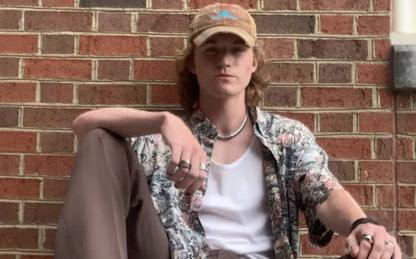
Withrow Starbucks Opens, Immediately Gets Shut Down Due to Allegations of the CoffeeGate Scandal
to stumble everywhere.
If you can, running into trash cans is a plus.
Don’t forget to walk directly in front of the police station because it is on your way home.
I cannot stress this enough. Be as loud and obnoxious as possible all the way to your dorm because you never know who is watching and who will be impressed by how much alcohol you consumed.
Congratulations. Somehow you made it home safe and sound. Time to do it all over again next weekend, and the weekend after that, and the weekend after that, and the weekend after that, all the way until you’re 21. Remember my wise upperclassman advice and stay safe out there, underclassmen.
sulli293@miamioh.edu
New Study Finds that People Who “Go Jim” See More Gainz Than People Who “Go to the Gym”
Delusional Oxford Man Tries to Steal the Seal, Claiming He Did It “By Order of the Peaky Blinders”
Kofenya and Withrow Starbucks Employees Host Lightsaber Duel to Decide Which Coffee Place Is A Better Hookup Spot
Miami Merger Divorce Rates Skyrocket After Videos of Dads at Dad’s Weekend Get Leaked
Guy Who Dumps Girlfriend Out of the Blue Says, “I’m Just Getting Ready For Mom’s Weekend”
Oxford Law Firm Now Hiring More Lawyers Due to Increase in Underage Drinking Cases
Student Who Never Goes to Class Outraged at His Midterm Grades
Riot Starts at Goggin after Red Savage Winks at Unidentified Fan
Dozens of Witnesses Reports That The of Ghost Helen Peabody Has Been Throwing Pumpkins at Students Around Campus
humor THURSDAY, OCTOBER 13, 2022 13
GRAPHIC
BY
EMILY
HOGAN
Will we continue to be a public ivy?
ELIANA RILEY THE MIAMI STUDENT
There was a saying in my hometown that the University of Mississippi accepted “anyone with a heartbeat.” Their acceptance rate was 88%.
When I was applying to college as a senior, acceptance rate was a large factor in my decision and the decisions of my peers. I believed, and still believe, that acceptance rate reflects the quality of education and of the student body at a university.
I never applied to Ole Miss. How, then, did I end up at Miami?
The acceptance rate at Miami was 92% as of 2020. In a recent article from The Miami Student, the admissions office attributes this spike to problems that COVID-19 brought on in the college application process. Although this number may not reflect cur rent trends in acceptance at Miami as of 2022, it’s not a question of accuracy, but a question of advertisement.
In the book “The Public Ivys,” author Richard Moll defines a Public Ivy as a university that offers a level of education up to par with the Ivy Leagues, but at a public school price. Miami Univer sity advertises itself as a Public Ivy, but Miami doesn’t rank with other prestigious Public Ivies anymore.
The University of Virginia (UVA) is considered to be a Public Ivy and currently ranks #25 in national universities, according to U.S. News, with an acceptance rate of 21%. In 2018, UVA ranked #25 with an acceptance rate of 24%. Their selectivity in the appli cation process and maintenance of their acceptance rate allowed them to keep their spot in the top 25 national universities.
By comparison, Miami University currently ranks #105. In 2018, Miami ranked #78 with an acceptance rate of 75%. When Miami’s acceptance rate increased, their ranking decreased sig nificantly and they lost the ability to advertise themselves in the nation’s top 100 universities.
But how do ranking and acceptance rate correlate to educa tion? What makes Miami’s education unlike Ivy League schools now or in the future?
My theory is as follows: an increased acceptance rate could reflect negatively on Miami’s prized education. Some individuals disagree, saying that Miami’s quality of education is still exem plary and that the acceptance rate has no correlation to education at Miami. For instance, Vice President of Enrollment Manage ment and Student Success Brent Shock holds this view in a recent article from The Student.
“[Acceptance rate is] a silly number because people assign
DEVIN ANKENEY ASST. OPINION EDITOR
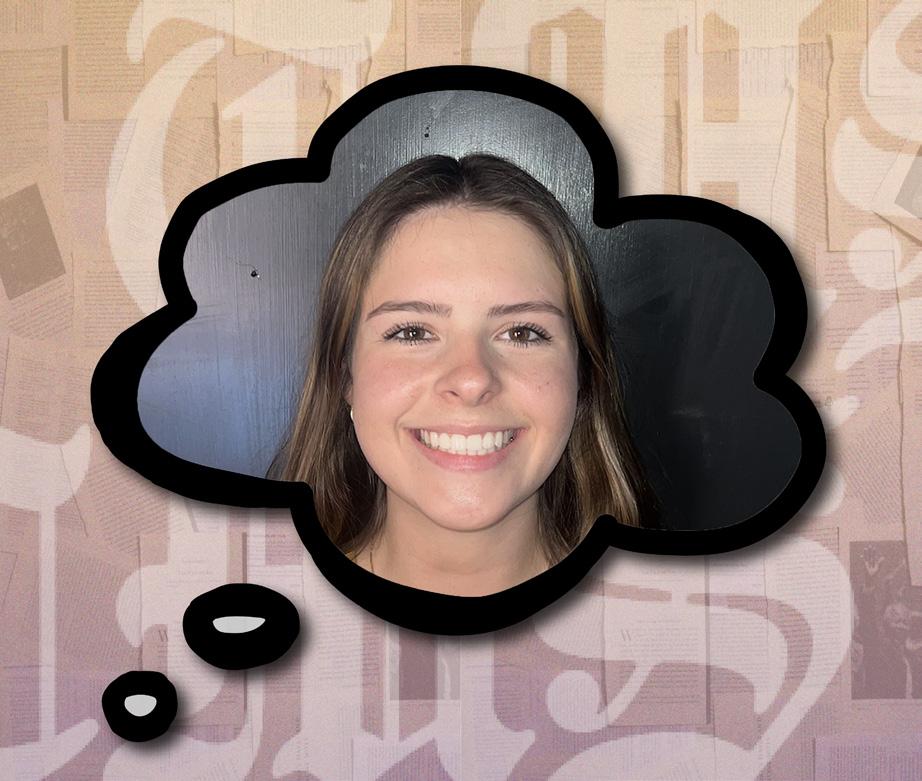
“Miami University and the Miami Tribe of Oklahoma are celebrating the 50th anniversary of the relationship between a sovereign Tribal Nation and a public educational institution.” Anyway, Happy Columbus Day! See y’all in class…
This past Monday, Oct. 10, was Indigenous Peoples’ Day, a day meant to celebrate and re member the stolen lands upon which we stand and to remember the lives lost and the cultures destroyed by imperialism and colonialism.
This past Monday, Oct. 10, was also World Mental Health Day, a day meant to recognize mental health struggles and educate more people about what they truly mean, subverting common understandings of an important topic that affects a large percentage of the population.
This past Monday, Oct. 10, was, however, also recognized as a day to celebrate the onset of both genocide and colonialism that resulted in the massacre of countless indigenous people. The holiday to which I refer is, of course, Colum
meaning to it, but it does not equal prestige and it does not equal the strength of the institution,” Shock said.
Acceptance rate could be nothing but a number, and it may not have a correlation, for now. I believe that in order to under stand the correlation between acceptance rate and education, we have to step away from the present and look ahead.
I believe that “92%” will stand out in future applicants’ minds, that they will bullet-point Miami under the heading “Safety Schools” in the back of their mind, especially in an age where ac ceptance rates for colleges seem to be going down.
In order to understand what I mean by “safety school,” I’m going to refer to applicants as either previously qualified or pre viously unqualified. By previously qualified, I mean future ap plicants who would have been accepted in 2018 at the 75% ac ceptance rate. By previously unqualified, I mean the other 17% because they would not have qualified for admittance in 2018.

For previously qualified college applicants, the increased ac ceptance rate might turn them away from Miami because they might believe Miami fosters an “easier” education, meaning the school could lose valuable potential students.
For previously unqualified applicants, Miami could be the obvious choice because they know they will be accepted, making the pool of applicants increasingly less qualified if the trend in acceptance rate continues.
In addition, the quality of education at any university begins with its students. The types of students accepted into a university shape its educational and social culture.
The staple of Ivy Leagues and Public Ivies is their commitment to education and learning. In this way, they must be selective in choosing candidates that will best represent their educational va lues and will be able to handle academic difficulty. This is why their acceptance rates are low; it ensures that they are accepting the most qualified students to uphold their reputation and com mitment to education.
When only eight out of every 100 applicants are denied admis sion, the likelihood that the university is accepting students that may not be up-to-par with their traditional educational require ments increases as opposed to Admissions’ precedent. As a result, an environment of leniency is created.
Leniency begins in Admissions, but it seeps into other aspects of college education. Education is not built solely on teaching and challenging students, but it also must align with the students’ in tellectual capabilities.
If education does not consider the academic ability of the stu
dent body and makes assumptions about the capacity of students to learn, you might find many students failing out if the curricu lum is too difficult. Therefore, an increasing number of unquali fied students accepted into the university could cause professors to sacrifice instructional time or adjust assignments to accom modate students falling behind in the curriculum. Their ability to educate affectly has to reflect the capacity of the students’ under standing to ensure student success.
Although not drastically, the quality of education could dege nerate little by little over time.
As a result, Miami may continue accepting 92% of applicants, and that’s a decision for Admissions to make. I am not doubting their methods because the question is not about whether Miami should lower the acceptance rate.
I came to Miami because I believed it was a Public Ivy, and I believed in its commitment to education. I’ve been challenged, and I’ve been pushed to grow in my learning. But I don’t believe that the education rivals that of other Public Ivies or Ivy Leagues, and I attribute this perspective partially to the acceptance rate.
To continue to advertise as a Public Ivy with a high acceptance rate simply doesn’t fit the definition. A Public Ivy is competitive. A Public Ivy is selective. A Public Ivy is not a safety school.
Miami seems to differ in these qualities, begging the question: Will we continue to be a Public Ivy?
Happy Columbus Day...?
bus Day.
There has been a long campaign to change Columbus Day to Indigenous Peoples’ Day ev erywhere, thus eliminating the tragically misun derstood and wrongfully-celebrated Columbus Day. However, in Ohio, the state government classifies the day as Columbus Day.
I absolutely do not have high hopes for this change. My faith in the Ohio State Government was depleted long ago (I believe I was still in the womb), but my faith in the Miami Univer sity administration still has a faint flicker. Yes, I am as shocked to be saying that as you are to be hearing it.
However, I have a good reason for this belief.
It rhymes with “Fiami.”
Ah, yes! The school that I currently attend is called Miami University. You know… like the indigenous tribe…
Our university so proudly touts its relation ship with the Myaamia Tribe of Oklahoma and appears to make it clear that we are educated on lands stripped from said people. The Myaamia Center seeks to educate the student body about the tribe and its relationship to Miami, espe
cially now, during the 50-year anniversary of this relationship. Even Art After Dark, one of MAP’s most popular semesterly events, touts a Myaamia weaving station year after year.
And yet, we still attend class own a day ma joritively referred to as “Columbus Day” by the university.
I cite three sources: the “Holidays” policy, the “Holidays, Standard Work Week, Overtime Pay, and Compensatory Time” policy and the Holiday Schedule.
The former two refer to the holiday exclu sively as “Columbus Day,” while the latter refers to “Indigenous Peoples’ Day/Columbus Day.”
I’ve complained before about the nonsense that is Fall Break, and I see no reason to get deep into the failures of the fall semester sched ule. However, seeing as Fall Break lands on the weekend directly preceding Indigenous Peoples’ Day and World Mental Health Day, why not give us a three-day weekend and use Monday as the third day?
Why not advocate for using it as a day of re flection and education about the Myaamia tribe? Why not advocate for mental health awareness
on the worldwide day to which it is dedicated?
Why not host events aimed at either or both of these incredibly important subjects and give often-ignorant students the opportunity to gain much-needed insight about the lands upon which we stand?
The time could be used so much more pro ductively. It is far past time to observe Indige nous Peoples’ Day on its actual date rather than a day observed over Thanksgiving Break. It is far past time to absolve ourselves of the usage of the phrase and celebration of “Columbus Day.”
Miami does not do nothing to educate its students about its relationship and history with Myaamia, but it does not do enough. Language is important. Reflection is important. Education is important.
Use the time you have, Miami, to do what you should, not what you can. Make Fall Break worthwhile, and take Columbus Day off of your holiday schedule.
Do more.
ankenedw@miamioh.edu
HALLE GRANT THE MIAMI STUDENT
College is an endless cycle of telling our selves that we “just have to get through this week,” but then what? We say the same thing when the next week rolls around. Though it’s definitely true that we need to take things week by week or day by day in life, those days or weeks cannot necessarily look the same every time.
It’s so easy to fall into a slump during college semesters when you’re in this end less cycle of telling yourself to work hard and get through the week. Next thing you know, you’re thinking that way semester to semes ter for the four years you’re here.
No one wants to look back on their col lege years and notice that this was the mind set they had — a mindset so detrimental to our mental health and overall well-being. As humans, we need and crave change.
In order to break this seemingly nev er-ending cycle in college, you need to im plement simple changes in variety in your routine. Implementing small alterations can add some excitement to your days, thus pre venting burnout.
When it comes to our class schedules, they don’t change week by week. We are in the same building, on the same day, at the same time, learning about the same subjects. Your class schedule can’t change, but when and where you study, eat, hang out and ex ercise can.
This could be as simple as studying in a different spot after your 10:05 a.m. class on Mondays and Wednesdays, or perhaps trying a new food for lunch one day.
Simply changing what time of the day you exercise, where you eat dinner and where you study will make each week seem less repet itive and boring. If you routinely go to the dining hall at 6 p.m. for dinner, treat yourself to dinner Uptown one night. If you usually study in Armstrong, try King Library. If you usually go to the Rec Center in the morning, try going at night.
During the second semester of my first year, I had a great weekly routine put togeth er, but it was almost too perfectly followed week to week.
I would go to the same classes day by day and study at either Armstrong or King
Library, depending on the day of the week. I would go to the Clawson gym before din nertime and do the same exercises depend ing on the day of the week. I would go to the Western dining hall and get almost the same dinner every night.
This daily routine worked for my sched ule, but it was so repetitive that I fell into the “just get through this week” cycle. The only excitement I felt was if I had something going on over the weekend or if I was going home for a break, but I believe that was mainly due to the fact that it was a change of scenery.
Once I realized how detrimental this was for my mental health and my overall view on being at college, I started studying at Star bucks and Kofenya Uptown. I started walk ing to Maple Street Station instead of West ern. I started working out at the Rec Center instead of Clawson.
But I didn’t make any of this permanent. It was all about switching up the endless mo notony of the same weekly routine.
After changing my routine more and more every week, I noticed a difference in my overall well-being and how I felt about school. I almost looked forward to doing my homework and studying in a new environ ment, so it motivated me to be productive and do well in my classes.
These small scenery or environment changes still followed my weekly routine that had worked for me the beginning half of the semester, but kept me from becoming burnt out over the course of the semester. Once the weather started to get nicer, it was even easi er to switch up my workout routine from go ing to the gym to walking on the trails down by the equestrian center and studying at out door tables instead of the library.
Though these may seem like such small changes to make, they make a significant dif ference. Not doing the same exact thing every day for weeks on end can keep you from get ting burnt out, whether it’s just with school or with your overall life at college.
My advice to you is to find at least three things you can change about your weekly routine this week. They can be large or small, but try them out and pay close attention to how those alterations make you feel about your quality of life on campus.
This just in: senior year is hard
AMES RADWAN OPINION EDITOR
By the title, I’m sure you’re thinking, “Well, duh, Ames. It’s college.”
However, I’m no stranger to college being hard — though that’s mostly because I tend to join too many things, and I’m no stranger to writ ing about that, either.
No, I came into senior year thinking it would be easy. I’m only taking two “real” classes, and the rest of my academic schedule is filled with thesis hours, ice skating and marching band — I have four homework assignments due each week, if that. Not bad at all, credits-wise.
Plus, there’s that whole idea of “senioritis.” If every senior I knew during my underclassman years could experience a case of it and still grad uate just fine, surely senior year couldn’t be the hardest one of my years at Miami. And yet, it is.
The problem with senior year is not that the classes are any harder than they have been in the past. The problem with senior year is not my in ability to say no to any organization or club final ly catching up with me.
The problem with senior year is that I can no longer enjoy the cushy college student life. Sud denly, I’m having to prepare myself for adult hood — real adulthood — and, to put it simply, I am drowning.
There are grad school applications, which are really the meat of it. I honestly don’t remember undergrad applications being this difficult — and I applied to fifteen colleges before finding my home as a RedHawk.
Between writing two or three mini-essays per university (plus some for scholarship applications), begging professors for letters of recommendation and updating my résumé, I easily spend a few hours each day just working on a singular application.
What’s scary about all that is that it may come to nothing. Graduate schools are notoriously tough to get into, no matter how much you want to pursue a graduate education. Worse, I’m ap plying to some of the country’s top universities — and some even outside the USA — so my chances of getting in are slim anyway.
And yet, I beat on. I want it, so I have to try, no matter how tired I may be after a long night of essay writing.
Of course, with the possibility of not mak
ing it into grad school looming on the horizon, I should also apply for real jobs. But that is even more terrifying.
Like most other college seniors, I have been surrounded by academia since I was six years old — and, technically, longer than that, seeing as my mother is a college professor.
As much as I may complain about school, I love it. I can’t imagine living in a non-academic world, which is part of why I hope to someday become a college professor myself. All I have ever wanted is to learn, as I’ve written in about six dif ferent drafts of graduate school applications just in the past week.
So I dread going to job fairs and filling out job applications for things I don’t want to do as much as I want to continue my education from a higher purview.
It’s hard. All of it is hard.
Part of this is an Opinion article for The Mi ami Student, yes. But something I have always loved about the Opinion section is that it gives writers an outlet for their feelings — for their opinions. Just writing this all down is making me feel better already.
I’m still stressed. I’m still struggling. But I know I can do it — push through and succeed.
For all of the seniors out there who may feel as though they’re floundering through their final year at Miami, or at any college, I want you to know you’re not alone.
We are all having our own troubles. Because of this, we must lean on each other and form a support network of friends, peers and future “real” adults. If we do this, we will learn and grow together. We will cry together, and we will laugh together.
And we will live together. We will survive to gether. We will graduate together, and move on to new things together.
Someday, all of this stress will just seem like ancient history, because that’s all it’ll be. But for now, we have to fight through it, and know we’ll be just fine.
If you or someone you know is struggling or overwhelmed, please reach out to Student Counseling Services and get the help you need and deserve.
rileyej4@miamioh.edu
granthn@miamioh.edu THURSDAY, OCTOBER 13, 2022Opinion 14 All you
have to do is get through this week… every single week
radwanat@miamioh.edu
OPINION WRITER ELIANA RILEY. GRAPHIC BY HANNAH POTTS.
We need proactive transparency from Miami
THE MIAMI STUDENT EDITORIAL BOARD
The members of the Editorial Board who reported on and wrote: “‘Resign.’: How Jason Osborne’s tenure as Miami’s provost came to an end” recused them selves from and had no part in this Edi torial Board discussion.
On April 11, Miami University’s then-provost, Jason Osborne, an nounced his resignation from his po sition, effective June 30. Today, The Miami Student published a detailed in vestigative story about the resignation, including previously undisclosed survey results gathered from faculty about Os borne’s tenure.
As an Editorial Board, The Student was disappointed, but not surprised, at the previous administrative culture that came to light due to this report.
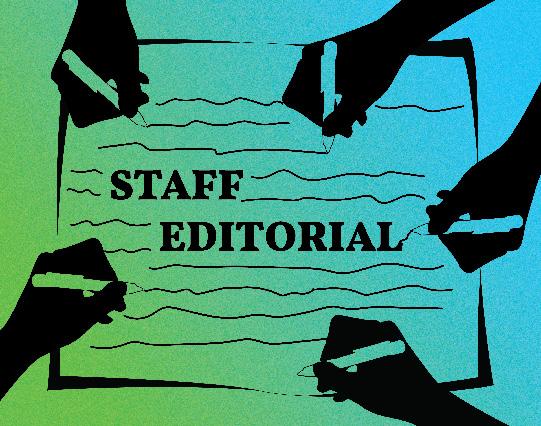
The Student reported on the results of the survey, which detailed poor scores on average in regard to Osborne and his job performance. Osborne will remain at Miami as special assistant to the pres ident until the end of this year, then, in accordance with his initial contract, tran sition to a tenured faculty position over the next year and beyond.
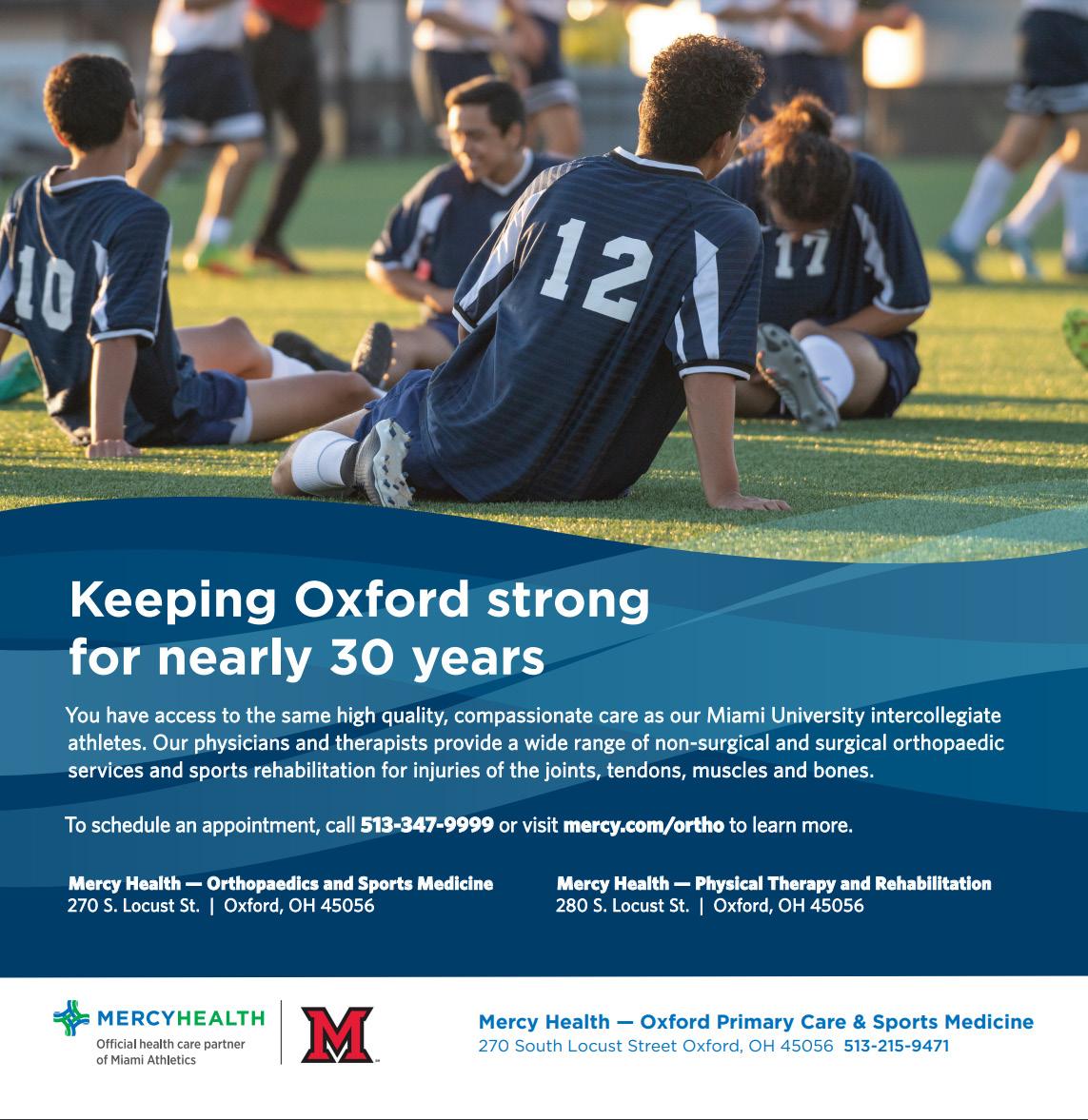
Osborne’s third-year report was not
published as a result of his resignation.
We are displeased.
As a result of this reporting, an ad ministrative culture, which protects its image before its community, has been brought to light.
We, as an Editorial Board, believe the report should have been published, and that the decision from the president’s of fice not to publish the report is emblem atic of a long-upheld status quo across the board.
The previous provost at Miami held the position for four years. Osborne held it for less than three years. The system of three and five-year reviews is both bro ken and unhelpful. The review process of high-ranking Miami administrators should be both on a rolling basis and take individual comments more seriously. This could help dismantle the aforemen tioned status quo.
There should also be a modified firstyear, scheduled review for new admin istrators rather than waiting for three years to hear feedback. This is especially true for a position as important and in fluential as the provost.
The survey was facilitated by Miami’s survey tool, Qualtrics, and was anony mous, though some complained about certain questions that suggested phras
ing could reveal identities.
There was a clear fear of retribution for full honesty among faculty members in these results. That is not okay.
The university reached a point where it is not listening to feedback from faculty and staff alike, and Miami has failed to live up to this standard before.
In the summer of 2020, at the height of burgeoning Black Lives Matter (BLM) protests, a retired Miami professor, Douglas Brooks, — who, although re tired, was still teaching online summer courses — allegedly called BLM protest ers Uptown “monkeys.”
A change.org petition was created the same day, June 4, 2020, calling for Brooks’ removal. Over 20,000 people had signed the petition by Oct. 12, 2022.
He was not fired.
Instead, an email was sent out (ironi cally enough, by former Provost Osborne himself) discussing the allegations, and Brooks stepped down from his position in a situation reminiscent of former Pro vost Osborne’s.
In both of these instances at Miami, faculty members and administrators were not removed after 1,400 mostly negative comments or 20,497 petition signatures. It is unsurprising, but disap pointing nonetheless.
It has come time for Miami to be a great deal better when it comes to the handling of student, staff and faculty concerns.
We need proactive transparency and an active feedback loop.
We do not think it should have taken Freedom of Information Act (FOIA) re quests to see the results of a survey that highlighted important faculty voices and should have been published in the first place.
It should have been finished, pub lished and distributed to the community.
Miami must change a culture that hides its failures, wrongdoings and alle gations and become forthcoming. This change would foster a community much happier with its administrative structure.
Allowing the truth to come to light would show that Miami is not just in it for the aesthetic reputation — they would show true caring for their students and faculty.
A faculty that claims to be disre spected and unheard also means a stu dent body that feels the same. We value transparency, and we care about the experience of all Miamians. Top-down approaches don’t work for us, and the perspectives of our faculty, staff and stu dents matter.
THURSDAY, OCTOBER 13, 2022 15
GRAPHIC BY MACEY CHAMBERLIN
photo story
Fall Break In The Mountains
CAITLIN DOMINSKI
THE MIAMI STUDENT

This fall break eight Miami University students, one couple, and the group’s two trip leads spent their time off backpacking in the Roan Highlands. The trip was one of many offered throughout the year by Miami’s Outdoor Pursuit Center. After classes on Thursday evening the group loaded the required hiking equipment into their packs and headed for their destination on the border of North Carolina and Tennessee.
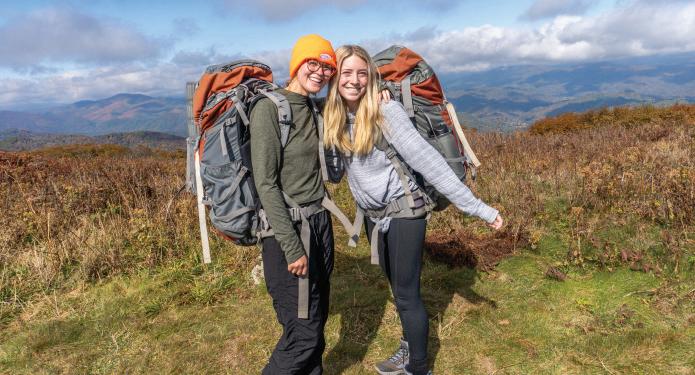

On Friday morning a shuttle drove the travelers up the mountain to the trail’s entrance and they began their journey into the wilderness. Each day they hiked for several hours, stopped for a backpacking style lunch, and continued hiking until they reached their campsite for the night. They then set up their tents and sleeping bags and started preparing for dinner.
The trip timing was perfect for viewing the mountain’s fall colors. The higher the group climbed the colder and windier it became, but it was worth the stunning sights below. The trees were all starting to turn beautiful shades of orange and yellow.



The adventure into the mountains would not have been possible without the group’s two trip leads, Eric Bachmann and Rae Webb. Bachmann is a professor at Miami in the department of computer science and software engineering, and Webb is studying to become a teacher. Bachmann and Webb taught the travelers how to best fit their gear in their packs, how to tape their feet to avoid getting blisters, how to filter water so that it was safe to drink and much more.
By the end of the three days everyone was sore and ready for fast food and a hot shower, but spending fall break in the mountains was definitely an experience to remember.

THURSDAY, OCTOBER 13, 2022
16
TRIP LEAD RAE WEBB JUMPING ABOVE THE CLOUDS IN HER PACK. PHOTO BY CAITLIN DOMINSKI
MIAMI STUDENTS LUKE MITCHELL AND ANTHONY JOHNSON GIVING THE CAMERA A THUMBS UP. PHOTO BY CAITLIN DOMINSKI
ON FRIDAY NIGHT THE TRAVELERS CAMPED IN THE GRASS FIELD THAT IS VISIBLE NEXT TO THE RED BARN IN THE BOTTOM RIGHT SIDE OF THE IMAGE. PHOTO BY CAITLIN DOMINSKI
THE MOST STUNNING VIEW OF THE MOUNTAINS FALL COLORS SHOWN THROUGH AN OPENING IN THE TREES. THE GROUP WAS EXCITED TO SEE A CHRISTMAS TREE FARM IN THE DISTANCE. PHOTO BY CAITLIN DOMINSKI
FIRST YEARS KATHERINE HAMILTON AND MEGAN NOWE POSING FOR A PHOTO ON A MOUNTAINTOP. PHOTO BY CAITLIN DOMINSKI
A VIEW OF THE TRAILS THAT THE TRAVELERS HIKED UP TO REACH THE TOP OF THE MOUNTAIN. IT IS IMPORTANT TO STAY ON THE WORN DOWN PARTS OF THE PATH IN ORDER TO NOT WIDEN THE TRAIL. . PHOTO BY CAITLIN DOMINSKI














 LUKE MACY
LUKE MACY
































 AMES RADWAN FOOD EDITOR
AMES RADWAN FOOD EDITOR

 AMES RADWAN
AMES RADWAN






















